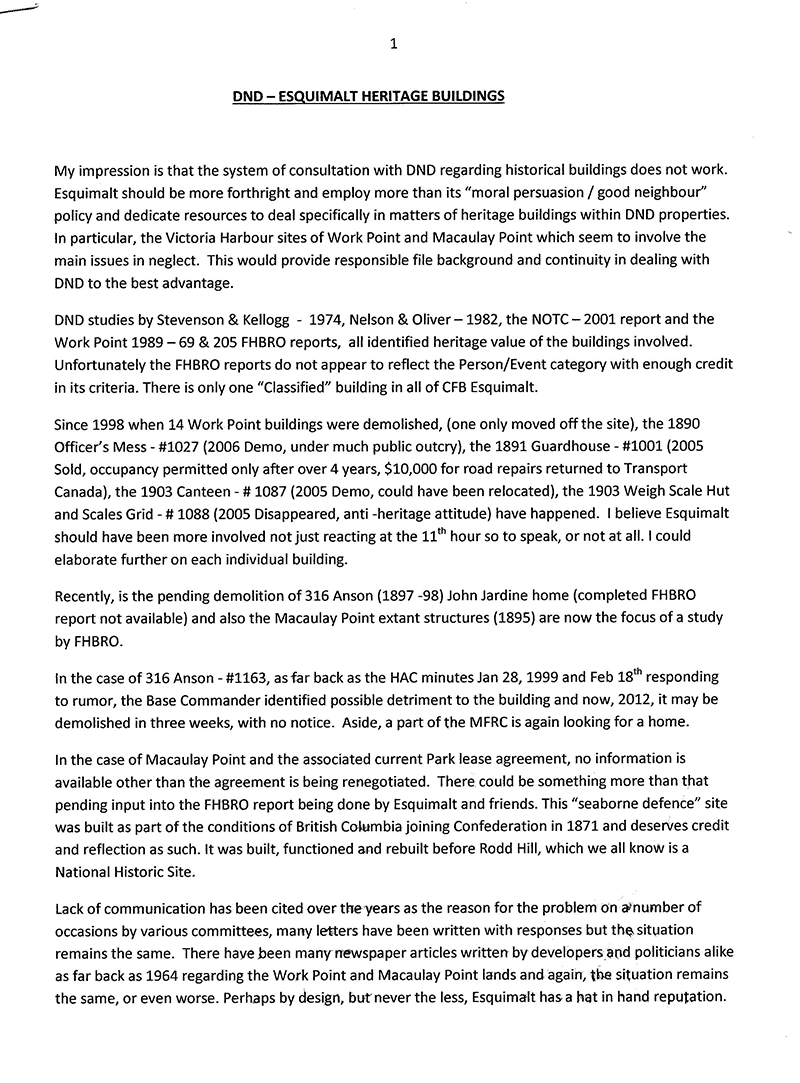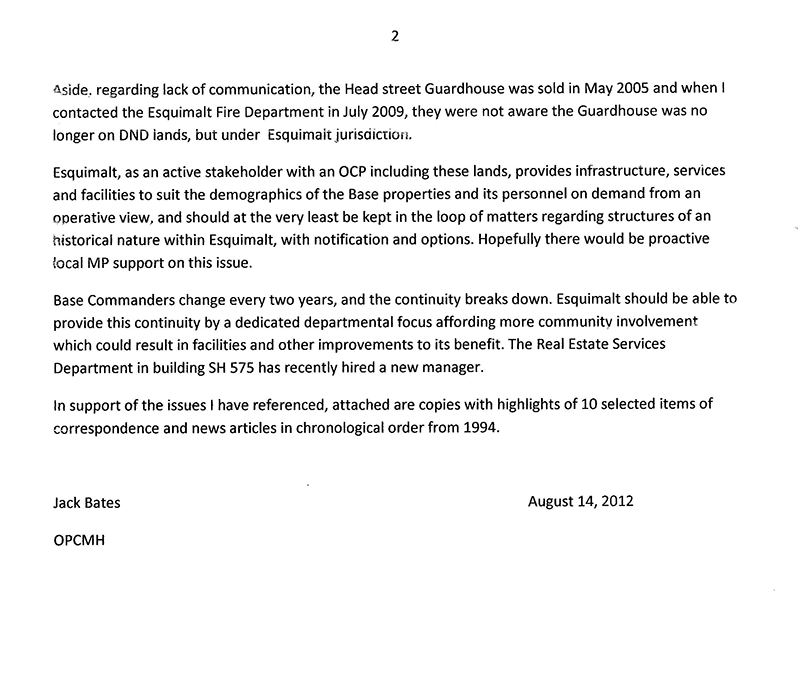 |
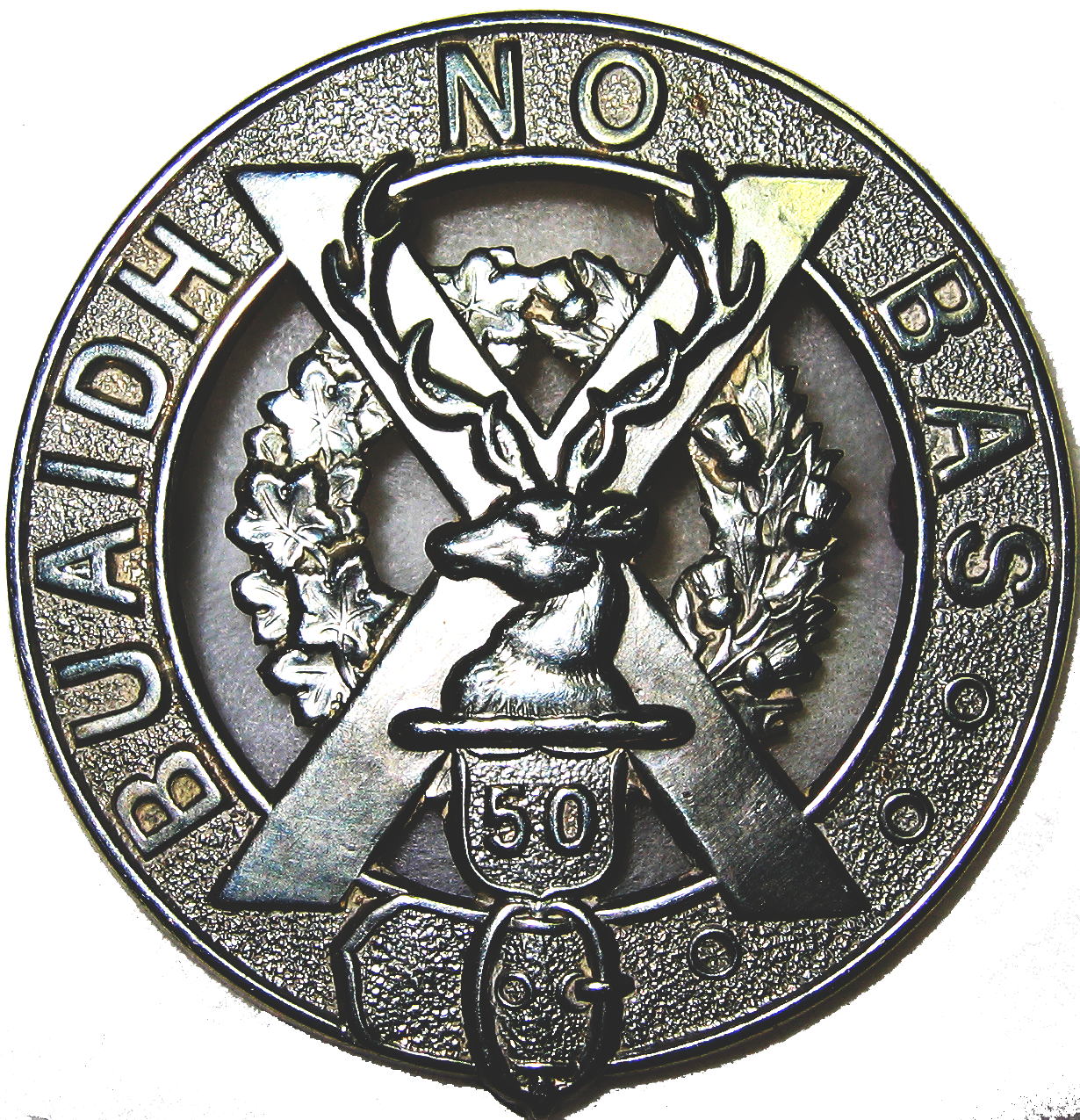 OPCMHVisitor No.: |
HISTORY OF WORK POINT BARRACKSby Jack BatesPART 10 — 1995 to 20222007Fort Rodd Hill HISTORIC ARTILLERY IN BRITISH COLUMBIA This report, written by Dale Mumford, is an introduction to the History of Artillery in B.C. and surviving examples of Artillery on Vancouver Island – Victoria and also Vancouver and New Westminster. Click here to view a PDF version of this report.
HERITAGE CANADA WORST LOSSES ARCHIVE Officer’s Mess and Quarters, Work Point Military Base, Esquimalt, British Columbia (2006 Loss) A federally “recognized” heritage building, the Officer’s Mess and Quarters was the last of its kind in Canada. It was listed as surplus to the needs of the Department of National Defence, and despite heritage and cultural groups working tirelessly to save the building with a possible conversion into a visual arts complex, it was “deconstructed” last spring. COLONIST LAMPSON FACES CLOSURE AS ENROLMENT RISES Click here to view article as a PDF. 2008National Archives of Canada Compiled by my friend Dale Mumford, a personality most dedicated to military history, is a list of personnel and units which were part of the Victoria/Esquimalt Coast Defences during World War 2. File: “Historical Notes”. Click here to view a PDF version of this report. The Lookout Army Greens Return to Work Point It’s been 10 years since army greens have filled Work Point’s halls, and instructor Sgt. Gord Cutting says they’re glad to be back. The army reservist recruits are staying at Work Point barracks during their basic training course. “We’re really looking forward to spending some time working side by side with navy personnel,” says Sgt. Cutting. “Even though we’re all military, we don’t often get the chance to work together and anytime we are in concert, even on a smaller scale, it allows us to form working relationships which benefit everyone.” Usually reservist recruit training is held at Albert Head, but due to scheduling the facility was unavailable for this rotation. “The Work Point facilities are more modern than those at Albert Head. There is current technology like Powerpoint installed in the classrooms, and the grounds offer more amenities,” he says. The training takes place on weekends from January to May, with recruits coming from all over Vancouver Island. During their weekend stays, they sleep in the old PPCLI barracks in building 1092. Their day begins at 5:30 am with inspections and physical training, followed by an afternoon of classes including weapons service, navigation and drill basics, more physical training and a study period. “They don’t get to hit the sheets until eleven o’clock at night,” says Sgt. Cutting. “It’s a long day made even longer by the fact these recruits have other commitments. Being a reservist is a second, sometimes even a third job for them.” The reservist training provides the recruits with the necessary instruction to be proficient as a reservist. “After basic training, they may want to continue on during the summer months with more advanced training,” he says. Sgt. Cutting is one of two instructors that has returned from a tour in Afghanistan, and plans on using his experiences as a unique teaching tool. “Bringing experiences to the table as a teacher gives a certain kind of credibility to what you’re teaching,” he says. “Even using small anecdotes of when the methods have been applicable in real life drive the lessons home a little more effectively.” Instructor M Cpl Ken Himes, a medic with the reserves, brings over 20 years experience to the teaching table. He was posted to Work Point 27 years ago with the PPCLI, and says while some of the facility’s scenery may have changed, it still has the same character. “The grounds are rich with great history and promises of future successes,” says M Cpl Himes. “At one point there were over 600 people posted at Work Point and each of them emerged from its gates a better soldier. I myself lived there and can attest to the limitless possibilities Work Point has to offer.” He, like Sgt. Cutting, is excited to be working alongside navy personnel. “There is of course a little rivalry between the two organizations,” says M Cpl Himes. “But at the heart of it all we each embrace learning from each other.” VICTORIA HISTORICAL SOCIETY PUBLICATION ANOTHER BRICK IN THE WALL For those researching the history of brick manufacturing here in the greater Victoria area, the publication by Cliff Chandler is a great resource. This of course associates with the many brick buildings built by the Royal Engineers in the Victoria-Esquimalt defences scheme from 1893 to 1906. Some bricks in the Cole Island guardhouse were actually imported from San Francisco.
For more on local bricks, Google – “Found Brick Bonds/opposite the city.” June 29, 2012. Goldstream News Gazette CRD FEARS TUG-O-WAR WITH FIRST NATIONS Land eyed for sewage treatment plant could fall within treaty claim The Capital Regional District is warning the Federal Government that a proposed sewage treatment system could pit the greater Victoria against First Nations. And it’s a position the CRD doesn’t want to be in. If the CRD chooses to proceed with its original plans to construct a sewage treatment plant at Macaulay Point, part of the $1.3 billion draft for secondary sewage treatment, federal land for the project will be required from the Department of National Defence. That land would have to be surplus to be considered for outside development, in which case it would be open to First Nations claims. The CRD board fears competing interests for federal land will put both parties in direct competition to the detriment of efforts to develop good relationships between First Nations and the region. There is also the possibility legal challenges would delay the sewage treatment project. “There isn’t a lot of land around available for (First Nations in the CRD) and they need new land,” said CRD chair Denise Blackwell. Esquimalt First Nation Chief Andy Thomas said Esquimalt First Nation holds 18 hectares, where 150 members live, but it’s quickly being used up. “Land is a big issue for us and we always got our ear to the ground,” Thomas said. Blackwell requested the appointment of a federal official to work directly with the CRD and neighbouring First Nations to seek a “win-win” solution to competing land needs. Treaty negotiations involve First Nations and the Provincial and Federal governments. But Federal Indian Affairs Minister Chuck Strahl does not see the Ministry as having a role in the issue yet. “I see this as a matter of discussion between you and the First Nations and would encourage you to continue to work closely with those First nations who may be impacted by the development,” Strahl wrote in a letter to the CRD. He also said lands may only be acquired by First Nations within existing policies and that Canada cannot guarantee requested land by First Nations will meet requirements to be considered for additions to Reserves. Although disappointed by the minister’s response, Blackwell is hopeful the Federal Government will intervene if a situation proves necessary. Songhees Chief Robert Sam did not return phone calls. For more to this topic, Google: “Historical Timeline of Waste Water Treatment in the CRD.” The Old Cemeteries Society Disaster at Point Ellice Bridge It was May 26, 1896, and Queen Victoria’s birthday celebrations were in full swing. The highlight of the holiday was an event at Macaulay Point, organized by the military. Everybody who was anybody planned to attend. Bicycles were oiled and carriages were pressed into service for the journey out of town across the Point Ellice Bridge. Picnics were packed. Excitement was in the air. Nobody wanted to miss this special occasion. Those who didn’t have self-pedalled or horse drawn wheels used the oldest form of transport of all – Shanks’ Pony – or rode the public streetcar. Car No. 16 was jammed with 140 merrymakers when it nosed its way across the bridge. The bridge was a wooden structure and not in good repair. Nor was it designed for heavily laden streetcars. On that fateful day, the inevitable happened. As Car No. 16 rumbled onto the span, there was a loud creak, followed by an almighty crash as car and passengers plunged into the waters below. Many who were trapped in the crowded car quickly drowned. Many more were killed or injured by falling timbers. A few lucky souls managed to escape and swim to shore. In all, 55 people lost their lives that terrible day. It was – still is – the worst streetcar catastrophe on record in North America. Since then, a wavering red light has been seen in the area on many occasions, most recently by two Australians nurses camping in the Point Ellice House garden. The red light seems to hover and glide just above the shoreline. Nobody knows where it comes from. Maybe it’s someone walking along the shore or rowing across Selkirk Water. Maybe it’s a figment of someone’s imagination. Or maybe it’s the special lamp of a grieving mother, father, sister or brother, searching vainly for a loved one who was lost in the terrible disaster at Point Ellice Bridge. Murder at Work Point Barracks When Anna first saw the man in the 19th century military uniform talking to the boy in the nightshirt, she wasn’t afraid – or even particularly surprised. Anna was used to seeing ghostly strangers in her home. After all, she and her family had lived in the apartment at Work Point Barracks since 1977, and everybody knew the place was haunted. In fact, Anna wasn’t the only one who’d seen the pair. An officer staying in the building had also seen the spirits. He awoke one night to find them standing in his room, a man in a high-necked military tunic engaged in conversation with a boy in night attire. Who were they? And why were they talking so earnestly in what used to be the Officer’s Mess at Work Point? History provides us with a possible explanation. Built in 1892, Work Point Barracks was the scene, some 18 years later, of a murder. On August 10, 1910, Captain Peter Elliston, Commander of No. 5 Company stationed at Work Point Barracks, was shot dead as he walked across the parade square at 9 a.m. The main suspect was Gunner Thomas Allen. A veteran soldier who had served in India, South Africa, Jamaica and Malta, Allen had a drinking and drug problem, and he was angry about Captain Elliston’s attempts to curb drug and alcohol us eon the base. Allen fled after the shooting, took refuge briefly at St. George’s Inn on Esquimalt road, then was captured in a nearby field. At the 1911 fall assizes, Allen was convicted of murder and sentenced to hang. However, he appealed the verdict, citing drunkenness, and the sentence was reduced to manslaughter. About a year later, during a clean-up at the barracks, Allen’s kit bag was found. In it was a diary showing clearly that he had deliberately plotted to murder Elliston. By then it was too late. Allen eventually served a 10 year sentence. When he was released, he left the island, and ended up selling newspapers in downtown Vancouver. Who was the ghost at Work Point Barracks? Could it have been Captain Elliston? He certainly would have been familiar with the mess, and may even have stayed there before his wife and family joined him from England. The family moved into a small house on Quadra street. Only a few months before her husband was murdered, Mrs. Elliston died there suddenly, leaving two young children Among the other strange happenings at Work Point, Anna and her husband occasionally saw a small boy, not one of their own running around in the TV room. Was the ghost Captain Elliston talking to one of his orphaned sons? Will they ever be able to rest? SAANICH HERITAGE REGISTER MARITME NAVAL/COMMUNICATIONS CENTRE At the beginning of the Second World War, District Superintendent of Radio, WJ Bowerman, supervised the construction of this building for use as a wireless radio and communications centre for the Federal Department of Transportation. Part of a network of stations used for defence purposes, the installation was near the Gordon Head Army Camp (see 3800 Finnerty Road). The basement contained power-generating equipment and the wireless equipment, located on the first floor, was connected to a radio mast some distance away. During the war, the building and the tower were surrounded by a high barbed wire fence, and guarded by sentries. The complex was off limits to military trainees at the camp. Architecturally, the building is of significant value as a fine example of the Streamline Moderne style. Designed to suit functional requirements, it followed a pure expression of the style, based on geometric form rather than detailing. Horizontality is emphasized by the curved steel-sashed windows. The construction was exceptionally robust, for maximum protection of the equipment, the walls are triple parged hollow red clay blocks one foot thick, and the basement walls, main floor and roof are one-foot thick concrete on robbed steel lath and joists. The building was designed to look like a house, with a circular formal drive in front to act as camouflage from the air. The building is now on the property of the University of Victoria.
2009TOWNSHIP OF ESQUIMALT Click here to view guardhouse sale documents as a PDF. WORK POINT BARRACKS Click here to view guardhouse documents as a PDF. OPCMH I met one of the owner’s principles and his representative agent today by chance at the Guardhouse when I was attending to the disarray around the site. I then contacted the agent regarding “adopting” the building for its preservation in July and he afforded me with keys and a thank you, good luck. A great start in preserving this landmark building which ideally represents the history of Work Point Barracks I thought. This to avoid the “demolition by neglect” scenario again which is a common theme practiced to eliminate unwanted buildings. The building is sound and still possesses value but needs upkeep. It had been upgraded to suit the conditions of sale in 2005 and a heritage clause was included as well as a professionally detailed Heritage Record Report required by the FHBRO, unlike that of the recently demolished officer’s mess. The Lookout Anniversary Marked With Refurbished Cairn Fifty years ago, Her Majesty Queen Elizabeth II came to Victoria’s Beacon Hill Park and presented her colour and a new regimental colour to Princess Patricia’s Canadian Light Infantry. Last Monday, PPCLI soldiers from the past and present gathered in the same spot to celebrate the regiment’s 95th birthday and to unveil and rededicate a refurbished stone cairn that marks that special occasion. Don Robertson addressed the crowd gathered on the former parade square to remember that extraordinary day when he was the commander of the colour party that escorted the old colour. Standing alongside fellow soldiers, from those he served with in the Second Word War to those about to deploy to Afghanistan, he said, “It’s hard to believe it was 50 years ago. It was a very dry summer and there was no pavement here to stand on. It was a dust bowl. There were 10,000 people here. It’s a good garrison town, Victoria.” The 1st and 3rd Battalions were once stationed at Esquimalt’s Work Point Barracks and a camp at Gordon Head. “We have over 700 monuments spread throughout the countryside,” said PPCLI Colonel of the Regiment and Master of Ceremonies BGen (ret’d) Joseph Gollner as he unveiled the cairn. “We are now working with our (PPCLI) Association branches to fix them up.” Regimental headquarters in Edmonton hired a Victoria company to restore the cairn to its former glory by power washing it and repainting each etched letter. Four members from Regimental Headquarters made the trip to Victoria to attend the celebration, which wrapped up with a lunch at the Trafalgar/Pro Patria Legion Branch 292 on Gorge Road.
About The PPCLI The regiment was stood up in Ottawa in August 1914, as a result of the offer of Captain Andrew Hamilton Gault to provide $100,000 to finance and equip a battalion for overseas service. Mobilization began on August 11th and eight days later it was completed as soldiers flocked to Ottawa from every part of Canada. In just over a week the regiment grew to 1,098 all ranks, with 1,049 of those members having seen previous service in South Africa or in the forces of the British Empire. LCol Francis D. Farquhar, an officer of the Coldstream Guards who was Military Secretary to His Royal Highness, the Duke of Connaught and Stathearn, the Governor General of Canada, was selected to command the new battalion. LCol Farquhar suggested the Regiment bear the name of the Duke’s youngest daughter, Her Royal Highness Princess Patricia of Connaught. The full title of Princess Patricia’s Canadian Light Mobile Infantry was too long for everyday use, and the new unit became known as “PPCLI”, with “PP’s” or “Pip Pip’s,” the most common variants. The Regiment has been awarded 39 battle honours, a United States Presidential Distinguished Unit Citation and two Commander in Chief Commendations for its overseas service. In October, the “Ocean Lady” occupants, 76 Tamil men, were held at Macaulay Plains and in the Gymnasium pending processing, it looked like a POW camp. WORK POINT BARRACKS This was the completion date for painting of the exterior of the “Stettler Building,” WP 1004 in Work Point. It was repainted in time for the 100th anniversary of the Royal Canadian Navy (RCN) in 2010. “Exterior paint of building is peeling and unsightly and presents an unfavourable first impression to students and visitors as detailed by Base Commander’s email to Venture Commandant dated 11 Feb 09.” It was noted that the building is FHBRO “Recognized,” and as such required adherence to certain procedures. Painting information from ATIF 2014-01272, photo 2013.
CHARLES DURFEE HARPER Donated to the Esquimalt Archives by Durf’s daughter, Mrs. Letson, courtesy Sherri Robinson.
These letters to his father describe his experiences after enlisting in the 231st Overseas Battalion on July 15, 1916 in Vancouver, onto when he was posted to the Royal School of Infantry at Work Point Barracks, training in Sidney and being notified of the Battalion’s intent to proceed overseas. He was an American, born in Topeka, Kansas, and was living on Granville Street in Vancouver when he enlisted. Arriving in England April 22, 1917, then serving in France from May 23, 1917 to February 12, 1918 with the 72nd Battalion, the Seaforth Highlanders from Vancouver, he had been wounded and eventually returned to Canada in June 1919. His CEF Regimental number was 1015782 and his complete service records are available at Library and Archives Canada. Interesting to note during his time at Work Point Barracks, how he describes the barracks, daily routines, the uniforms, his own personal reflections and the eagerness of returning to Vancouver knowing training is over and they were to “get on with it” late in February, 1917.
WORK POINT BARRACKS This was the completion date for painting of the exterior of the “Haida Building,” WP 1020, in Work Point. It was repainted in time for the 100th anniversary of the Royal Canadian navy (RCN) in 2010. Painting of the building was initially proposed in 2006, and not being slated for demolition at that time, it was finally given the go ahead in 2009. It was noted that the building is FHBRO “Recognized,” and as such required adherence to certain procedures.
2010PW&GSC In 2010, the Public Works and Government Services of Canada performed a legal survey of parts of the DND property at Macaulay Point, taking photographs and producing two proposed VIP plan. Proposed are two lots: Lot A possibly the Macaulay Point Park fence line and & B, Clifton Terrace r/w or road allowance. This project was PW&GSC Project # R.038846.001, SF # 3202.01 and BC # 3121.01 and references DND 2013 / 2014. These preliminary plans were never registered to my knowledge. Click here to view as a PDF. 445 HEAD STREET The Land Titles plans for the R/W to be dedicated as road, the extension of Head St. in front of the Guardhouse, was signatory on March 30, 2010 by the parties involved, the Township of Esquimalt and Transport Canada. The sale of the Guardhouse and property was May 9, 2005. FOCUS MAGAZINE ESQUIMALT’S FORGOTTEN FARMER THE MAN FOR WHOM MACAULAY POINT WAS NAMED WAS A TRUE-BLUE HBC MAN Old bridge, new bridge…sewage systems…proposed power link through his precious acreage…One can only wonder what the first working occupant of Esquimalt would think about all the goings-on there today! It’s 160 years since Donald Macaulay took up residence in the area. James Douglas, instructed by the Hudson’s Bay Company to find suitable land for a Puget Sound Agricultural Company venture, had divided Esquimalt into four potential farm properties. The HBC started the process of hiring three bailiffs in England. Meantime, Douglas appointed Donald Macaulay. Macaulay had no knowledge or experience of farm management, but he was a hard worker and would, Douglas decided, get the PSAC project off to a flying start. In 1850, Viewfield Farm’s 600 acres did indeed boast some of the finest views in Esquimalt. Its borders ran west from Lime Bay (at the foot of present day Catherine Street), encompassing Work Point, Macaulay Point and Saxe Point before turning north to the top of the hill on Old Esquimalt Road, east toward Craigflower Road, then back south to Lime Bay. Situated immediately west of the Songhees Indian Village, Viewfield Farm was closest to Fort Victoria by name and by nature. Like so many fellow HBC officers of that time, Donald Macaulay was a Scot, and was an HBC employee of long standing. He had travelled by canoe and portage across the mountains to the West Coast around 1834 and was stationed at Fort Simpson in northern BC, where he and his native-born wife Margaret had raised their family. By the time the Macaulays moved to Esquimalt, they had four daughters. Donald and Margaret’s marriage was solemnized by Reverend Staines at Fort Victoria at the same time as their girls were baptized. Two more daughters were born while the family was at Viewfield. Macaulay was a man of few words who didn’t see the need to waste time cultivating friendly relationships with his neighbours. The sign above the entrance to his farm was short and to the point: “All drivelers who drivel this way, man woman or child-please shut the gate.” There are no pictures of Macaulay, but Dr. J.S. Helmcken, chief surgeon at Fort Victoria, later described him as “a highlander or crofter, a most trustworthy man...long and spare.” Trustworthy he may have been, but depsite his head start, Macaulay didn’t have much success with Viewfield. According to Douglas’s census of the white population four years after Macaulay’s arrival, Viewfield Farm still only boasted 14 people, nine of whom were children under 15. Three dwelling houses were recorded. Chief products listed were sheep and wool, some horses, cattle and oxen, seven milk cows and a few pigs. Most telling of all, only 35 of Viewfield’s 600 acres had been cleared. The combination of rocky, densely forested land and logging equipment limited to bare hands and axes comprised a huge obstacle to agriculture. Once felled, trees left a maze of stumps with thick roots that had to be cut out, and then the stumps had to be rolled away and burned. As Dr. Helmcken later recalled about his own land at View Royal, “The stumps…never seemed to rot. I have seen them pretty solid after 20 years.” By 1860 Macaulay had had enough. He was ready to return to Fort Simpson. The HBC, disillusioned by poor returns from the PSAC farms, closed all four of them and took over the assets. Two of the Macaulay girls had married while the family was at Viewfield, so after a few years Donald Macaulay came back to Fort Victoria, where he was put in charge of the HBC powder magazine at Esquimalt. In 1868, a munitions barge he was working on in Esquimalt Harbour sprang a leak, and Macaulay drowned. By that time, Viewfield Farm’s 600 acres of PSAC promise were almost forgotten. Eventually, Victoria spread west to cover them. In the 1870’s, Macaulay Point was fortified, and at the outbreak of World War Two, Macaulay Plains disappeared under army buildings. In the 1940’s the farm’s flat lands near Work Point Barracks became the site of wartime housing for shipbuilders and their families. Eclipsed by the social and shenanigans of Thomas Skinner, Kenneth McKenzie and Edward Langford, the three bailiffs who followed him to the area, Donald Macaulay’s efforts have gone largely unrecognized. Macaulay Street still runs south from Esquimalt Road toward Macaulay Point, but these days the only reminder of Viewfield Farm is a tiny street just north of West Bay that still bears his name. — DANDA HUMPHRIES
WORK POINT BARRACKS The Queen’s Own Rifles of Canada Celebrating 150 Years of Service to Canada In the Presence of the Colonel in Chief Unveiling of Commemorative Cairn At Naval Officers Training Centre - VENTURE BACKGROUND Today we are gathering to commemorate the service of two of the Battalions of The Queen’s Own Rifles of Canada. Formed in Toronto in 1860, the Regiment is Canada’s oldest continuously serving infantry unit. Two of its Regular Army Battalions were stationed in Victoria during the cold war, 2nd Battalion returned from Korea in 1955 to Gordon Head Camp, now the University of Victoria prior to departure to Germany on 1957. The 1st Battalion returned from NATO duty in Germany in 1963 and was at Work Point Barracks until re-designated Third Battalion, Princess Patricia’s Canadian Light infantry in 1970. The Queen’s Own Rifles have a long and proud record of service to Canada, fighting its first engagement in 1866 near Ridgeway, Ontario against Fenian Raiders from the United States. The deaths of 9 soldiers at that time heralded sacrifices in campaigns throughout the 19th, 20th and 21st centuries serving in the North West Rebellion, Boer War, First and Second World Wars, Korea, NATO duty, Cyprus and other Peacekeeping Operations and today in Afghanistan. The Cairn being unveiled today symbolizes the dedication and sacrifice of soldiers of the Regiment in War and Peace. It also reflects the affection, admiration and appreciation of all riflemen of the Queen’s Own for their service to the Regiment and to Canada of our Colonel in Chief, Her Royal Highness, Princess Alexandra, KG, GCVO. We will celebrate her 50 years as our Colonel in Chief as well as our 150th birthday. She will travel to Calgary, then on to Toronto to participate in events commemorating this very significant chapter in Canadian military annals. Following the Reception here today, which is for Queen’s Own Association members and invited guests, Her Royal Highness will depart at 2:55 pm to join her other regiment, The Canadian Scottish for a reception at Bay Street Armoury. Unfortunately at the last moment Princess Alexandra sent her regrets as she was not able to attend the ceremony.
______________ 150th Anniversary of The Queen’s Own Rifles of Canada Plaque Dedication Tuesday, April 20, 2010 at 4:00 p.m. Historical Background The gathering today, at this site of the old main gate to Gordon Head military barracks, marks a number of historical events in the military history of this area. Since before Confederation, the Victoria and district have been regarded as strategically important to the Royal Navy and later to the Maritime Forces of Canada. Royal Artillery shore batteries protected the west coast until the early 1900’s, when Canadian gunners took over the task of harbour defence. As part of bringing BC into Confederation, the Canadian Pacific Railway was completed to the lower mainland and Canada provided Armed Forces for the protection of this area. Gordon Head served for years as a signals station and later in World War II, as an officer training school. The 2nd Battalion, The Queen’s Own Rifles of Canada moved into the barracks in 1955 after it returned from Korea. The role of the camp changed significantly in late 1957 when the battalion was deployed to Germany for NATO duties. The battalion was the last army unit to occupy what was to become a major part of the University of Victoria. L Col John Doerksen, the officer who “turned over the keys,” is with us today to participate in the unveiling of the new plaque. Her Royal Highness, Princess Alexandra, KG, GCVO our Colonel in Chief, officially opened the Centennial Stadium on 19 May, 1967. She was attended by a 100 man Guard of honour and the Bugle band from the 1st Battalion, as Canada celebrated its 100th birthday year. The Colonel in Chief sends her very best wishes on this, The Queen’s Own Rifles of Canada’s 150th anniversary, and “thanks for remembering” to all present today and also to the University of Victoria for its contribution to, and support of, this event. Music courtesy of 5th (BC) Field Regiment, Royal Canadian Artillery band. The plaque reads: QOR of C BADGE Unveiled by Colonel Paul F. Hughes, CD There were two plaques already in place, and this one was placed in the center between the two. On the left: THESE GATE POSTS MARK THE ENTRANCE TO THE GORDON HEAD MILITARY CAMP. FROM 1949 – 1959, OFFICERS AND SOLDIERS OF A VARIETY OF REGIMENTS AND CORPS WERE STATIONED HERE. CANADIAN POW’S RETURNING FROM JAPAN WERE RECEIVED HERE AND FAMILIES OF CANADIAN VETERANS LIVED HERE FROM 1946 – 1950. LATER BOTH ARTILLERY AND INFANTRY UNITS USED THE CAMP, THE LAST BEING THE 2ND. BN, THE QUEEN’S OWN RIFLES OF CANADA. THE CAMP, INCLUDING THE ADJOINING NAVAL RADIO STATION, WAS PURCHASED BY THE UNIVERSITY OF VICTORIA IN 1959. ERECTED BY THE ALUMNI ASSOCIATION OF THE UNIVERSITY OF VICTORIA AND THE DEPARTMENT OF NATIONAL DEFENCE 1981. On the right: The plaque is a scaled model of the camp as it was at its peak time, showing the huts, roads and the two existing entrance posts mentioned on the plaque above. WORK POINT BARRACKS ROYAL CANADIAN NAVY
It was noted for the 2010 Royal Canadian Naval Centennial that numerous buildings were painted in naval blue colour. WP 1004, WP 1020, WP 1031 and WP 1079 were refinished as was the commemorative 3” WW 1 anti-aircraft gun at the saluting battery, not really a naval gun. August 13, 2010 The MV Sun Sea arrived in Esquimalt Harbour carrying 492 migrant passengers, 380 men, 63 women and 49 children. This followed the MV Ocean Lady which arrived here in October 2009 with 76 Tamil migrants aboard. DONALD MACAULAY The British Colonist, Monday Morning, September 21, 1868 INQUEST: An inquest was held on Saturday by the Coroner, upon body of Mr. Donald McAulay, at Esquimalt. It appears from the evidence that shortly before the deceased went out fishing in a small risky boat and that on drawing in a stone which he used as an anchor, he fell overboard, and was unable to extricate his hand from the rope in which it had got twisted, by some means. When discovered in the morning by the milkboy going across to the naval hospital, the hand was seen a little way beneath the surface. Under the circumstances the jury found a verdict of accidental drowning. Mr. McAulay was an employee of the Hudson Bay Co. for over thirty years, and at the time of his death had charge of the company’s powder magazine at Esquimalt. The funeral took place from St Andrew’s church yesterday. Deceased was over sixty years. There was no Victoria Times newspaper in 1868. Inquest – Saturday, September 19, 1868 Funeral – Sunday, September 20, 1868 Death – Friday, September 18, 1868 Burial - ID # 716 Pioneer Square Cemetery as per the Old Cemetery’s Society. Unfortunately there are no written records or plot maps to be found for Pioneer Square (Old Burying Ground). There are very few grave markers left in situ, as most of them were moved in the 1920’s to turn the area into a park. Danda Humphries wrote an article in the March 2010 issue of Focus Magazine on Donald Macaulay. On September 16, 2009, Donald McAulay’s great, great granddaughter, Constance O’Leary, submitted a request to the Township of Esquimalt for a commemorative plaque to be placed on the Point. Her request was redirected to the DND as Macaulay Point Park is leased from the DND. She followed up on that November 5th. No results known. 2011RICHARD LINZEY Richard Linzey researched and forwarded this file to me regarding activities of the Royal Marine Artillery (RMA) and the Submarine Mining Establishment (SME) at Esquimalt from 1883-1895. This includes nominal roles stationed at Esquimalt, at Work Point Barracks and Signal Hill. Click here to view file as a PDF document. COLONIST (D11)
June 20, 2011 The Statement of Significance for the former Work Point Barracks Guardhouse, WP 1001, was written by the Esquimalt Heritage Advisory Committee and approved by the Esquimalt council. The building at 445 Head Street will be added to the Esquimalt Heritage Registry and forwarded on to Heritage BC. The Staff Report was DEV-11-049. STATEMENT OF SIGNIFICANCE Civic Address: Legal Description of Property: Description of Historic Place: This one storey Wood Frame Military Guard House was constructed in 1890-91 on land that was the principal access point to the newly established Work Point Barracks and Garrison Headquarters of MD (11) BC (1887), home of Canada's most westerly army garrison. Apart from the role to control access and provide facilities for security personnel, it contained four short term detainment compounds with cement and brick walls over to two feet thick, which are fixed to the building structure. It served as an integral part of this military establishment from the time of Queen Victoria to the present Queen Elizabeth II. During that time, Canadians in general and British Columbians in particular, marched passed the Guard House to serve during the Boer War, the Great War, World War 2, also the Korean War, and peacekeeping. Some great persons in history checked through this entry point including Royalty. The building is in situ although it has been sectioned off from the rest of the surviving barracks and through a trade between DND and the Department of Transportation, ended up in the ownership of a private consortium. Heritage Value: 1. Architectural Significance No. 1 Head Street is one of the last surviving Guard Houses of this design in Canada; the other two are in eastern provinces of Quebec and Nova Scotia, although one has been rebuilt (see attached photos). No. 1 was designed by the Department of Public Works, based on preliminary sketches provided by architect, Henry James of the engineering Department of Militia and Defence. It was one of the first of three buildings constructed during the founding stage of Work Point barracks, from 1887-91, constructed from fir originating from the large stands felled at Work Point by C Battery. Virtually intact, complete with arcaded porch, it had some minor modifications to the exterior; the construction of the rear annex and trim removed from the front pillars. All doors and fenestration are original except 2 large front window panels. The interior remains intact with its original four caved ceiling cells, the latter had bars and doors removed and two converted to washroom space. 2. Social Significance It is visually prominent by virtue of its location at the gate to Work Point Barracks, through which all visitors and military personnel had to pass to enter or exit the site. Some notably historical figures checked through this gate such as Major James Peters, Lt.-Col. Josiah G. Holmes, Lt.-Col. Arthur Currie (later Sir Arthur), HRH Prince of Wales 1919 (abdicated), Brig-Gen. Andrew G. L. McNaughton, Gen. R. O. Alexander, Lt. Col. Joan Kennedy (started CWAC), Maj-Gen. George R. Pearkes, Her Majesty Queen Elizabeth II and lastly Lady Patricia Ramsay, Colonel-in-Chief in residence at WP Officers' Mess. Among the many military units that served at Work Point and passed through this landmark was a who's who of regiments that defended Canada, which included the Canadian Artillery (later known as the Royal Canadian Artillery), the Royal Marine Artillery, Royal Engineers, and Royal Garrison Artillery, B Company, Princess Patricia's Canadian Light Infantry (later the Queen's Own Rifles of Canada) and finally the 3rd Battalion Princess Patricia's Canadian Light Infantry. 3. Cultural Significance The Guard House stands out because of its distinctive design and proportions and as a landmark to a significant stage in the development in BC's Coastal Defences. As the gateway to the historically rich Work Point Barracks, this guard house was definitely linked with role of coastal defence and part of the process in British Columbia's joining Confederation. The spin-off was the injection of community influence from the rest of Canada, into the social fabric of British Columbia. Character-Defining Elements: Key elements that define the heritage character of #1 - Head Street include:
At the time of my hosting an “open house” at the Guardhouse on June 5th, the Barracks mess hall, building # 1090, was being demolished, it was built in 1954. The area was later paved. WORK POINT BARRACKS “Cec” was a very interesting fellow, with a great connection to Work Point Barracks as an Artillery Officer. He married the daughter of the ever popular Col. JC Cave, whom we all new and respected. I have mentioned Colonel Cave before, “The Cave Block,” the Teen Town in the fifties, former B Company PPCLI, and artifacts from him are displayed in the Nixon Building showcase outside the gymnasium. In his writing Cec mentions in 1889: Lt. Col. Holmes requests a 9-pdr gun to be situated at Work Point to fire noon and evening gun salutes. This quickly became the “heart-beat” of Victorians who laid down tools for lunch with the noon gun and locked down with the 9 p.m. salute, as the sailing masters in port set their chronometers. This became the duty of the orderly officer and continued until the last artillery unit departed Work Point Barracks in 1957. WORK POINT CHRONOLOGY-2 (revised 31/07/11) CHRONOLOGY OF WEST COAST SECURITY AND DEFENCE Bronze Plaque at entrance to the Fort Rodd Hill Historic Site: 1848 — HMS Constance, a sailing frigate (later a screw-frigate) of 50 guns first Royal Navy ship to enter Esquimalt Harbour, just five miles along the coast from Victoria, then little more than a Hudson’s Bay Company log fort. 1849 — Victoria becomes capital of new colony of Vancouver Island. 1854-55 — First three buildings constructed for the Royal Navy are on Duntze Head and were to serve as a hospital during the Crimean War. 1858 — Fraser River Gold Rush – Victoria only harbour when US ship Commodore arrives with 400 miners bound for the Fraser River. There were 100 more prospectors on board than there were citizens in Victoria. Within four months, Victoria was overshadowed by a tent city of more than 6,000 American fortune seekers. The colonial governor urgently sought military and police assistance from the British government. The Royal Navy assisted. 1859 — The Colonial Office sent 165 Royal Engineers and 164 Royal Marine Infantry. This force was encamped at Queensborough (New Westminster) on the Fraser River. Pig War incident on San Juan Island involving American and British forces raises local tensions because Oregon Treaty failed to clearly delineate borders in the Gulf Islands. 1860 — Victoria Pioneer Rifle Corps first volunteer unit and composed entirely of blacks. 1862 — Esquimalt becomes new base for Royal Navy Pacific Squadron. Lack of shore batteries or garrison to defend harbours raises fear in case US Civil War spills over. 1866 — Colonies of Vancouver Island and British Columbia (mainland) amalgamated as united Colony of British Columbia. 1867 — Alaska purchased from Russia for $7.2 million by the United States. 1871 — British Columbia enters Confederation as a province. The West Coast is remote from any defences. The Fenian threat extends the Militia system into British Columbia. 1872 — The Militia Adjutant General, Col Robertson-Ross, visits British Columbia to organize a Militia of five companies of infantry and two of artillery. He also forms new Military District No. 11 (British Columbia) headed by a Deputy Adjutant General, Lieut. Col. C.F. Houghton, who is to raise the new companies of militia. 1873 — Two militia companies of Victoria Rifle Volunteer Corps formed. 1875 — New Commander of Canadian Militia visits Victoria and has Ottawa develop new coastal artillery defence plan for Victoria and Esquimalt. 1877 — War between Russia and Turkey threatens Britain’s communications with India. 1878 — Russian squadron of five ships arrives in San Francisco; war with Russia seems imminent and alarms the West Coast, particularly the Royal Navy in Victoria. The navy provides guns to defend Victoria and Esquimalt. Military District 11 (BC) enlists artillery militia volunteers and starts gun drill with three gun detachments on 9 March at James Bay on two naval 64-pounders. Construction of earthworks for gun positions starts at Finlayson Point and Macaulay Point using local labour. 20 July, the newly formed militia Victoria Battery of Garrison Artillery fires the first 7-inch gun at Macaulay Point. (The 5th (BC) Field Regiment, Royal Canadian Artillery in Victoria perpetuates the Victoria Battery today.) Russia withdrew from Turkey in July and the West Coast scare subsided. The British admiral commanding the RN Pacific Fleet ordered a full-scale review of the inadequate defences of Victoria and Esquimalt harbours and strongly advocated permanent fixed defences. 1879 — Lt-Col Thomas B. Strange, Senior Inspector of Artillery, Ottawa, visits Victoria with Col W.J. Lovell, R.E. to determine the defence needs of the Pacific Coast. Following a more modest plan than his British counter-part, he recommends the formation of a four-battery brigade of garrison artillery to increase the number of militia gunners and improve their training. 1883 — Major J.G. Holmes arrives as Acting Deputy Adjutant General of Military District 11 (BC) and as commandant of new Royal School of Gunnery, to be formed on the West Coast. He forms a militia regiment of garrison artillery of four batteries, one in New Westminster and three in Victoria. The Militia Act 1883 also authorized C Battery for Victoria, but to be raised later after Northwest Rebellion. Royal School conducts courses for militia artillery. 1885 — Russian tensions again seen as possible threat to Esquimalt, Nanaimo coalmines that supplied the RN steam-driven warships and the western terminus of the newly built CPR in Vancouver-Port Moody. The Dominion government agreed to provide a permanent artillery garrison to Victoria, but after the conclusion of the Northwest Rebellion. 1887 — Dominion Government forms C Battery, Canadian Artillery with drafts of 50 men each from A Battery, Kingston and B Battery, Quebec to form a permanent garrison in Victoria. On 10 Nov, Mayor John Grant of Victoria greeted Major James Peters and C Battery, the first Permanent Force unit to arrive on the West Coast of Canada. C Battery temporarily housed in old Agricultural Hall in Victoria. Lt.-Col. J.G. Holmes, now commander M.D. 11 selects Work Point, located halfway between Victoria and Esquimalt harbours, as site of future barracks for C Battery and garrison headquarters. Gunners of C Battery clear Work Point of giant fir trees for builder, James Holland. In 1887, there was very little of modern armaments for coastal defences that had been provided by the Admiralty to the Victoria Battery in 1878. The best were three 7-inch rifled muzzle-loaders at Macaulay Point, an 8-inch on Brother’s Island. The rest were ancient 64-pounders at Finlayson Point and Victoria point. 1888 — C Battery placed on Active Service and dispatched to the mouth of the Skeena River responding to a reported Indian uprising. 1889 — Lt-Col Holmes requests a 9-pdr gun to be situated at Work Point to fire noon and evening gun salutes. This quickly became the ‘heart-beat’ of Victorians who laid down tools for lunch with the noon gun and locked down with the 9 p.m. salute, as the sailing masters in port set their chronometers. This became the duty of the orderly officer and continued until the last artillery unit departed Work Point Barracks in 1957. 1890 — C Battery occupies the newly built Work Point Barracks including Officers’ Mess and Quarters, three barracks, stores room and stable. Lt-Col Holmes was first Commandant at Work Point and first occupant of the Commandant’s quarters in the Officers’ Mess. 1892 — Menzies Street Armoury is built in Victoria. 1893 — 24 May, Regiment of Canadian Artillery composed of A, B and C Batteries, is redesignated “The Royal Canadian Artillery”. 18 Aug — Dominion agreed to Britain building an imperial fortress at Esquimalt on a cost-sharing basis. Royal Marine Artillery arrives 18 Aug via new CP Railway, to take over Work Point Barracks. C Battery departs following day bound for Quebec. Maj. Peters promoted to Lt-Col. and to command M.D.11 (BC), vice Lt.-Col. Holmes. Royal Engineer detachment (a major, captain and 20 sappers) from Halifax opens Works Office at Work Point to plan and supervise building of the new fortress. This includes coastal artillery emplacements, the ubiquitous red brick barracks, dockyard buildings, married men’s housing at Work Point and married officers’ housing at Signal Hill. Between 1893 and 1906, the British installed the most modern of coastal artillery commencing with the installation of disappearing six-inch guns, three at Macaulay Point and three at Fort Rodd Hill across the entrance to Esquimalt harbour.1899 — 75 Royal Marines with families were relieved by 322 Royal Garrison Artillery from Halifax, causing second wave of construction at Work Point, mostly of red brick. One officer and 25 men of 5(BC) Regiment, Canadian Artillery departed Victoria for South Africa as members of the 2nd (Special Service) Battalion, Royal Canadian Regiment. 1905 — Admiralty officially closes Esquimalt naval station. 1906 — 17 May, the last British Army garrison to depart Canada left from Victoria. No. 5 Company, Royal Canadian Garrison Artillery, the Royal Canadian Engineers and the Royal School of Instruction took responsibility for the defences. Reverting back to Canada, Work Point again under Col J.G. Holmes continues as Fortress HQ with the new Canadian Army garrison of 120 all ranks that was only a third the size of the departed British. The core of the new units came from the transfer of 3 officers and 37 gunners from RGA and 31 RE sappers. The British garrison found Work Point much to their liking. They left with regret and a host of very pleasant memories, having established many local contacts socially. 1908 — Col. James Peters returns as Commander M.D. 11 (BC). Lt.-Col. Arthur N. Currie took command of 5th (B.C.) Regiment Canadian Artillery militia. (He would rise to the rank of Lt. General commanding the Canadian Corps during the Great War.) 1910 — 7 Nov. HMCS Rainbow, an obsolete British cruiser transferred to Canada, arrives at Esquimalt as its sole ship with 300 British officers and Men who are on loan to a newly created Canadian navy for two years, until Canadian sailors are recruited and trained. 9 Nov, Esquimalt British naval base is transferred to Canada, giving new purpose to the Dockyard and the long-established Canadian artillery defences on the Pacific Coast. Witnesses included British Columbia Lieutenant-Governor Paterson, Premier Richard McBride, Col. R.I. Wadmore, M.D. No.11 (BC) Commander and Lt-Col (later General Sir) Arthur Currie, commanding officer of Victoria’s militia 5th (B.C.) Regiment Canadian Artillery. 1911 — The fledgling Canadian Naval Service takes over Dockyard from Britain. M.D. No.11 (BC) Headquarters returns to Work Point Barracks. The Officers’ Mess and Quarters becomes home to district commander and garrison officers. Once again, the defences of the West Coast depended mainly on militia units that had been trained to a very high standard by their British mentors. 1914 — All batteries were manned by 4 Aug with hastily mobilized regular and militia gunners within Esquimalt Garrison. The British Columbia government had secretly purchased two submarines in Seattle for $1,150,000 and removed them a day prior to war because of the Neutrality Act. The morning of the 5th as the submarines approached Esquimalt harbour, nobody had notified the artillery of this fact. An alert officer, recognizing the submarines as “British,” stopped the guns from opening fire, thus averting tragedy. 1918 — 5th BC Regiment was demobilized in August after manning most of the coastal defences and training and dispatching 777 officers and men overseas during the war, from Work Point Barracks. All equipment and fortress stores were turned back to the local permanent force 5th Company Royal Canadian Garrison Artillery. 1919 — HRH, The Prince of Wales, visits Victoria in Sept. and receives guests at Work Point Officers’ Mess and Quarters during his visit. 1920 — B Coy PPCLI posted to Work Point under MD 11(BC), as a local defence force for the coast artillery defences and Esquimalt harbour and coaling station. 1922 — School of Artillery reconstituted at Macaulay Point to train regulars and militia. 1924 — Two 6-inch QF naval guns replaced the two obsolete 6-inch disappearing guns at Macaulay Point. 1925 — 5th Company at Work Point re-titled 5 Heavy Battery, Royal Canadian Artillery. 1928 — Gen A.G.L. McNaughton, PC, CH, CB, DMG, DSO, while a Brig-Gen, becomes Comd M.D. 11(BC) and Comdt Work Point Barracks. His primary task was to produce a new defence plan for the West Coast. Joint Staff Committee Pacific Coast recommended modernization of obsolescent coastal defences. These included searchlights and batteries of 9.2-inch, 6-inch and 6-pounder duplex guns, patrol and fighter aircraft and light and heavy anti-aircraft guns. 1929 — McNaughton departs for Ottawa on promotion to Maj-Gen and appointment to Chief of the General Staff at age 41, the youngest CGS in Canadian history. 1937 — Because of the depression, little had been done to replace the obsolete guns. Mountings for two 9.2-inch guns at Albert Head were started. 1939 — By spring, the two 9.2-inch guns from Signal Hill had been installed at Albert Head. The re-titled 5th BC Coast Brigade was reorganized in Victoria to at least partially man the coastal defences. Readiness was in a poor state and there was no defence plan. 26 Aug, 5th BC Coast Brigade mans six artillery sites of the Victoria-Esquimalt Fortress by 226 all ranks, with headquarters at Work Point. 1940 — Pacific Command established in October with Maj.-Gen. R.O. Alexander as General Officer Commanding and to be district officer commanding of Military District 11 (BC) headquartered at Work Point Barracks. Canadian and American officers meet at Work Point Headquarters, Esquimalt-Victoria Fortress, to coordinate the defence of Juan de Fuca Strait. 1941 — Americans agreed to loan two 8-inch railroad guns to Canada for emplacement at Christopher Point, covering the entrance to Juan de Fuca Strait. 5 Mar — Officer Training Centre (Western) opens at Gordon Head to train new officers. 29 Aug, Lt.-Col. Joan Kennedy opens Work Point office to enlist women for CWAC. 7 Dec, Japanese strike Pearl Harbour. Joint US/Canada operational procedures activated. Top priority was installation of anti-aircraft defences at Esquimalt-Victoria Fortress. All production of 3.7-inch and 40-mm AA guns directed to Pacific Coast. Fortress reinforced with infantry, field artillery and armoured units over several months. 1942 — 1 Jan, Canadian Coast and Anti-Aircraft Artillery School opened at Esquimalt. 25 Feb, Queen Elizabeth enters Esquimalt dry dock for refit; local fear of air attacks. 18 Mar, Maj.-Gen. R.O. Alexander now Commander-in-Chief, West Coast Defences (Sea, Land and Air). 30 May, Lt.-Gen. K. Stuart, Chief of General Staff, arrives at Pacific Command to take personal control, while still continuing as C.G.S. General Alexander posted to Ont. 20 Jun, Public panics over Japanese invasion of Aleutians and shelling of Estevan Point. New 6th Division Headquarters under Maj.-Gen. Potts moves into Work Point Barracks, Esquimalt with brigades in Nanaimo, Port Alberni and the Esquimalt-Victoria Fortress troops under command. (The Work Point Officers’ Mess was busy!) 2 Sep, Maj.-Gen. G.R. Pearkes, V.C. becomes G.O.C.-in-C. Pacific Command. 30 Nov, Pacific Command and MD 11(BC) HQ moved to Vancouver as part of Joint Operational Headquarters. 1943 — During the year, 6th Division grew to 11,462 all ranks on Vancouver Island. October – 6th Division HQ moved from Esquimalt to Prince George. (Kiska) 1944-45 — Coast and anti-aircraft defences gradually reduced as threat subsided. 1946 — Work Point Barracks gains new Royal Canadian School of Artillery (Coast and Anti-Aircraft) until1953. School commandant also Commander Esquimalt Garrison. Two AA batteries, 119 and 129, part of garrison but located at Gordon Head Camp. 1949 — Cold war creates NATO. Militia expands. RCSA(C&AA) at Work Point conducts camps and courses for all militia AA units from Western Canada from live-firing points at Macaulay and Albert Head. Also trains regulars for Germany. 1951 — Korean War brings expansion of Canada’s military for both Korea and Europe. Work Point Barracks undergoes major renovations. Many red brick British buildings circa 1904 are demolished. Construction of new Men’s mess hall and barrack blocks, as well as married quarters at Macaulay Point. RCA Officers’ Mess (Bldg 1027) has ground floor partitions removed to enlarge dining/ball room and the ante-room. Nearly 200 officer cadets of the Canadian Officers Training Corps from universities across Canada, undergo 8-weeks of summer artillery training at RCSA, Work Point. Many wartime officers, now Victorians, become associate members of the RCA Officers’ Mess at Work Point that once again resumes social prominence in Victoria. 1953 — School closes and 119 MAA Battery moves from Gordon Head Camp to Work Point Barracks, to be joined by 3rd Field Squadron RCE on return from Korea. 1955 — 119 MAA Battery reduced to nil strength; 129 MAA Battery converted to 4th LAA Battery and moved into Work Point Barracks. 2nd Queen’s Own Rifles of Canada moved from Korea to Gordon Head Camp. 1957 — 4th LAA moved to Picton, Ont. The 2nd QOR of C moves to Germany. 3rd Field Engineer Squadron moves to Chilliwack, B.C. The Work Point RCA Officers’ Mess property is moved to Home Station at Camp Shilo, Man. Coast artillery defences removed. Gordon Head Camp becomes site of University of Victoria. 1 Nov, First Battalion, Princess Patricia’s Canadian Light Infantry arrives from Germany to take over Work Point Barracks and the Work Point Officers’ Mess, alternating with the Queen’s Own Rifles of Canada on subsequent rotations to Germany. 1982 — Lt. Col. F.D.H. Nelson (Ret.) conducts a CFB Esquimalt Military Heritage Report with Dr. N.E. Oliver and within that lengthy document Building 1027 is of primary importance and rated fourth out of over 100 heritage structures surveyed. 1994 — PPCLI departs to Edmonton. The Naval Officers’ Training Centre (Venture) moves from Dockyard to Work Point Barracks. 2001 — CFB Esquimalt conducts a survey study of the buildings and lands at Work Point Barracks through Number Ten Architectural Group and BKG Consulting Group Ltd. called Phase II NOTC (DCC Project No. HQ 011 03, June 4th. The Officers’ Mess and Quarters 1027 and a number of other buildings were given a Heritage significance of Primary Importance and suggested a re-use. These buildings were also divided into two Heritage Precincts (Groupings.) Historic Work Point Officers’ Mess Bldg 1027 was declared surplus to naval needs and a Request for Proposal was issued to remove the building. Included in the applications answering Request for Proposal was a Capital Plan for re-use of the Officers' Mess and Quarters (1027) by the Professional Arts Initiative (later called Work Point Arts Project Society). Base Commander Capt (N) Adrian Round decides to re-assess removal of Building 1027. 2004, 2005, and 2006 — Three successive Ministers of National Defence refuse to support submission declaring Work Point Officers’ Mess and Quarters (Building 1027) and precinct in Esquimalt a national historic site to be preserved. 2006 — Jun 02, contract let by DND/CFB Esquimalt to RALMAX and “deconstruction” commenced immediately by gutting the centre portion of this historic centre-piece of the first Canadian barracks designed and constructed in Canada between 1888 and 1890 at Victoria, B.C. Compiled by: September 1, 2011 I was given the prized set of two books, “PPCLI 1914 – 1919” by Ralph Hodder-Williams printed in 1923, as a gift from Ed Hansen, ex PPCLI and President of the PPCLI Retired Warrant Officers and Senior NCO’s Club here in Victoria. Rosemary and I had met Ed and Linda Hansen in 2001 and became friends. Earlier Ed had given me a VHS recording of the 1989 Trooping of the colours held at U Vic Stadium where my dad was one of two special guests, both WW1 veterans and ex members of the PPCLI. Sadly Ed passed away on January 29, 2012. He would have had the presence and strut but also the compassion of the venerable “Regimental Sergeant major.” December 10, 2011 I had known of George Wilkinson, referred to me a number of years ago by my uncle Walter Phillips who knew of him as they were both born in Esquimalt and attended Esquimalt schools together. Finally today I visited George and confirmed that he had joined “B” Company PPCLI in 1935 and knew my dad and many others of the time. At the formal re-opening of the Guardhouse by the PPCLI cadets on January 31, 2012, George was asked to be the reviewing officer and he obliged them. It was a very memorable event. George has since revealed many of the interesting and amusing local happenings, with great detail, of Work Point Barracks from 1935 to 1939 when he departed for active service with the PPCLI. The house that George and his family lived in at 1342 Liverpool St is now Building # 69 in Naden. It is used for social purposes and within there is the “George Wilkinson Room” named after him. One particular note was the expression of duty spoken when on guard duty at the Work Point Barracks Guardhouse, or Guardroom: “I am sentry No 1. My beat extends from the main gate to the end of the sidewalk. I will walk my beat in a smart and soldier like manner, and I will pay complements to all Officers. I will turn out the Guard at Reveille and Retreat and to all General Officers. I will turn out the Guard to all unarmed parties numerically stronger than the Guard. I will remain at my post until properly relieved.” As you can tell, George has tremendous recall! 2012By the end of January, the two remaining 1939 vintage huts at Macaulay Point, #’s WP 1184 and 1203, were demolished. They were last used a few years ago by the “Rainbow” Sea Cadets. The “CFB Esquimalt Urban Search and Rescue” facility is currently being built on the site. Victoria News Esquimalt Guardhouse New Home to Army Cadets Move Marks A Return of Army Presence at CFB Esquimalt’s Work Point Laughter fills the room where five friends sit. Their dark green uniforms stand out against the milky white walls of the new home of the largest army cadet corps on the island. The teenage boys quickly set to work studying the lessons before them. The 59 year old corps relocated to the 21 year old guardhouse at the entrance to CFB Esquimalt’s Work Point property in November. The move will be officially celebrated Tuesday (Jan.31), marking the cadet’s happy return to their former home at Work Point, after four years spent sharing space at high Point Church in Vic West. “We like this building a lot more,” said 15 year old cadet Sgt. Curtis Whittla. “Its just ours.” The youth with 2483 Princess Patricia’s Canadian Light Infantry, Royal Canadian Army Cadet Corps say they feel more connected to their Corp’s history. Until 1994, Work Point was home to the 3rd Battalion PPCLI before it moved to Calgary, then Edmonton. The guardhouse passed from the Department of National Defence to Transport Canada, before it was sold in 2005 to Esquimalt First Nation and the Songhees Nation. It has largely sat empty for years. When the cadets moved in, they were thrilled to find two jail cells that were used when Work Point was home to one of the first units of the Royal Canadian Artillery. The building dates back to 1891. “I think it’s nice to be back in a building with military history,” said 15 year old cadet Sgt. Alastair Dillstone. The move caps off much effort spent building the corps from 12 members in 2008 to 50 today. The male and female youth, ages 12 to 18, come from across Greater Victoria to learn from seven instructors. ”I’m happy, excited, thrilled,” Capt. Madeleine Dahl, the corps’ commanding officer, said of the move. “It’s definitely going to build on our success.” The guardhouse serves as home base to the cadets’ adventure training program, but cadets also hone their skills at the Work Point gym and parade square on week nights and weekends. “It’s definitely where we belong as a cadet corps,” said 16 year old cadet Sgt. Tyler Calhoon-Cardinal.
Army cadet Sgt. Curtis Whittla, 15, stands in a doorway inside the new home of the largest army cadet corps on the island. The 50 member group moved into the 121 year old guardhouse at the entrance to CFB Esquimalt’s Work Point property in November. More Online. Check out our photo montage of the army cadet corps in its new digs at the Work Point Guardhouse.
January 31, 2012 The 2483 PPCLI Royal Canadian Army Cadet Corps held a ribbon cutting ceremony in honour of the opening of the Guardhouse as their headquarters and training centre. It was well attended by many various groups all grateful that the cadets will have a new home back at Work Point and also with respect for the building itself to be re-occupied with a community purpose. This is a great story. The Lookout Cadets Return to Work Point In front of local military and civilian representatives, the 2483 Princess Patricia’s Canadian Light Infantry, Royal Canadian Army Cadet Corps (PPCLI, RCACC) officially relocated to their new accommodation in Work Point last week. The Corps cut the ribbon on their lease of the historic 121 year old guardhouse that stands just outside the gate of the current Work Point perimeter. For the past three and a half years, the Corps had been conducting their activities at the Highpoint Community Church in Vic West, but with their numbers quadrupling to 50 cadets this year, they needed more room. “The church kindly took us in when we were homeless,” says Capt. Madeleine Dahl, the Corps Commanding Officer. “We had a great relationship with them, but we outgrew the space.” A ribbon cutting ceremony took place under clear and crisp night skies as representatives from the Township of Esquimalt, Esquimalt and Songhees Nation, the Army Cadet League of Canada, the Regional Cadet Support Unit (Pacific), the PPCLI Association, several representatives of various Royal Canadian Legions as well as other service associations, the Naval officers Training Centre, and other friends and families of the Corps attentively looked on. Following an inspection of the Corps by Esquimalt native and second world war veteran, LCol (ret’d) George Wilkinson, a handful of representatives gave monetary donations to Capt. Dahl on behalf of various groups and organizations. With the formal portion of the ceremony complete, the Corps awarded a few of its personnel with medals and promotions before everyone entered the building for a tour. As the large crowd socialized over cake and other goodies, LCol (ret’d) Wilkinson shared the significances of an organization such as the cadets for younger generations, relating it to the tight knit groups he fought with in wartime. “They get to mix with other kids and learn how to take a knock in the nose maybe,” says the former member of “B” Company PPCLI with a laugh, “You’ve got to get them away from mom (for a bit), it’s a good life for a kid.” The one story wood framed guardhouse provides the corps with adequate space to hold weekly meetings. Being a stone’s throw away from Work Point means they also have access to additional facilities to host their larger events. “We have a great relationship with the Naval Officer’s Training Centre so we us e the Nixon Gym as well as their seamanship classrooms,” say Capt. Dahl. “We do our training over there so the cadets have to march back and forth a little, but we appreciate the support from the navy tremendously.” Built in 1891 by Ontario contractor George McFarland, the guardhouse became unoccupied in 1994 when the 3rd Battalion PPCLI was relocated away from Work Point. In 2005, it was sold by Transport Canada, who had acquired it from the DND, to Xhamasung Holdings LLP, a company comprised of the Esquimalt and Songhees nations. After the sale, Jack Bates from the Organization for Preservation of Canadian Military Heritage, was given permission by the Esquimalt and Songhees representatives to adopt the facility and perform routine maintenance. When Bates heard the Corps needed a new home, he arranged through proper authorities for the building to have a new tenant. Before being sold, the guardhouse was one of three military guardhouses in Canada’s Federal Heritage Registry. When it sold and was no longer a federal building, it lost the designation. Currently it’s listed in the Esquimalt Community Heritage Registry and applications are being prepared to apply for Provincial Heritage Recognition and reinstatement to the Federal Historic Places registry once again. When originally constructed, the guardhouse at Work Point coincided with a main gate, fencing, a cook house, married quarters and a canteen for “C” Battery, Regiment of Canadian Artillery. Although minor exterior modifications had been previously made, the building remained intact until about 1940 when it was modified with guard’s sleeping quarters in the rear, new cells, and a washroom. Imperial and Canadian military personnel have been filing past the building from Work Point to fight in conflicts dating back to the Boer War. The PPCLI Army cadets are accepting new recruits between the ages of 12 - 18, and meet on Tuesday evenings at the work Point Guardhouse from 6:30 – 9:30 pm weekly. Photos Above: On Jan. 31, 2483 PPCLI RCACC officially moved into their new accommodations at the historic Guardhouse at Work Point. In front of a throng of invited military, veteran, and civilian guests, the ribbon was cut on their new home marking their return to Esquimalt for the first time since 2008. Here Cdt Lemieux, C/CWO Worth, Chief Andy Thomas from Esquimalt Nation, Lynda Hundleby, Acting Mayor of Esquimalt, and Capt. Madeleine Dahl commanding officer of the corps cut the ribbon at the Guardhouse’s front entrance. Right: Capt. Madeleine Dahl, commanding officer of the corps, and Chief Andy Thomas from Esquimalt Nation, cut a cake that was made for the night’s festivities. Above: C/CWO Worth stands at attention with LCol (ret’d) George Wilkinson, a former member of PPCLI, a Second World War veteran, and Reviewing Officer for the inspection of the Corps. PRE WORLD WAR 1 SCRAPBOOK PRE WORLD WAR 1 SCRAPBOOK Click here for Pre WW 1 Scrap Book of newspaper articles on activity of the militia units in the Victoria area. This is a very large PDF file edited and replaced June 2023. March 27, 2012 The FHBRO contacted the Township of Esquimalt, advising them of pending demolition of the pioneer 1897 John Jardine house at 316 Anson street, WP 1163, and asked for historical information. This caused much reaction in the community and correspondence to follow. Don Mann Excavating was awarded a contract for demolition and after community reaction, including the Hallmark Society, it was revised to include a sell and relocation option, Nickel Bros. House Movers were then consulted and involved. March 2012 The FHBRO notified interested parties that they are doing a study of the buildings and fortifications at Fort Macaulay. I have offered to provide historical data for their study and amongst correspondence it was revealed they were not to have a site visit included. This was a problem with the report on 316 Anson to which I have challenged. Heritage Canada Foundation Earlier in the year I had provided information on request by Carolyn Quinn for the story of the Guardhouse and its possible extension of existence by being re-occupied, and gratefully by the PPCLI Army Cadet Corps. An article called “Esquimalt’s Jack Bates – The Guardian of the Guardhouse” was in the “Faces and Places” section in June’s issue of the Heritage Magazine. (See PDF Faces and Places article) St. SAVIOUR’S CHURCH On a visit to St. Saviour’s Church, I noticed two wall plaques of great interest. One dedicated to the commemoration of three persons: Staff Sergt. Major FW Ellicott, A.S.C., Staff Sergt. HW Shorey, R.E., and Second Mate Owen Hartopp. For newspaper articles see the Colonist September 27 and 28, 1904 (8). St. Saviour’s church was the Esquimalt Garrison Church at the time.
Also on the wall was another commemorative plaque, this time to honour those who gave the supreme sacrifice. There is no date on this plaque.
June 8, 2012 In support of the Esquimalt Heritage document regarding Work Point Barracks as the HQ of Pacific Command from October 30, 1940 to November 30, 1942, including operational responsibilities of the G.O.C. in C., following are excerpts from three publications and Victoria Directory listings: Jack Bates OPCMH The CANADIAN ARMY 1939 – 1945 DEFENSIVE MEASURES IN CANADA Page 42 In October, 1940, came the authorization of a Pacific Command parallel to that already set up on the Atlantic. The first G.O.C. in C. was Major General RO Alexander. This command comprehended the whole of Military Districts No. 11 and 13 (that is, the provinces of British Columbia and Alberta, the Yukon and the adjacent portions of the North West Territories) Page 44 Early in June 1942 the war came closer to British Columbia. The Japanese now occupied the islands of Kiska and Attu in the Aleutians. On the 20th of the month shells fell on Canadian soil when an enemy submarine fired at the wireless station and light at Estevan Point, Vancouver Island. There was much anxiety on the west coast, and General Stuart, the Chief of Defence Staff, himself assumed for some time the duties of G.O.C. in C. Pacific Command. In September, General Pearkes, formerly G.O.C. 1st Canadian Division, returned from England to take over this appointment. __________________ SIX YEARS OF WAR, VOL 1. Defending The Soil Of Canada 1939 - 1945 Page 172 (1942) However, they produced on 10 March a new formula under which the senior member of The Joint Services Committee on each coast would be designated Commander in Chief of the defences on that coast, and would exercise, in emergency, strategic direction of the other two services as well as tactical command of his own. This arrangement the War Committee approved on 18 March.* Under it General Alexander became Commander in Chief, West Coast Command. 126. See footnote 126: “Documents in H.Q.S. 5199 – VOL. 2.” When the two new divisional headquarters were formed, the 6th Division (commanded by Maj Gen AE Potts) took responsibility for Vancouver Island, with its headquarters at Esquimalt. __________________ “FOR MOST CONSPICUOUS BRAVERY”, the biography of Major General GR Pearkes VC, by Reginald Roy. ISBN 0-7748-0068-2. Page 174 (1942) Pearkes from McNaughton: “that I was to take over and be responsible for all the defences of the West Coast, and that the Air Force and the Navy would come under me in an emergency.” Page 175 PACIFIC COMMAND Lt Gen Stuart to JL Ralston M of ND: Noted that the person holding the appointment of the General Officer Commanding - in - Chief, Pacific Command should be acceptable to the other two services, should have overseas experience, should be “be one who already has the confidence of the Canadian people as a good fighting soldier,” and finally, “have the energy and knowledge needed to train and fight this important command.” Stuart mentioned he had consulted the Deputy Chief of Naval Staff and Deputy Chief of the Air Staff, both of whom, he wrote, “consider the appointment an excellent one.” When Pearkes arrived in Esquimalt on 6 September he assumed charge of a command which encompassed all of British Columbia, Alberta, the Yukon Territory, and the District of Mackenzie of the Northwest Territories. Page 178 Lt Gen Stuart, acting GOC in C, Pacific Command, and CGS, drew up a document to define Pearkes authority. 12 See page 361, footnote 12: D.Hist., “Instructions for the Guidance of General Officers Commanding -in-Chief, Atlantic and Pacific Commands, September 4th, 1942.” Page 180 Pearkes was also charged with co-operating with the senior Naval and Air Force commanders in the preparation of plans and conduct of combined operations under the general instructions issued by NDHQ. It was his task, too, to initiate and control all measures requiring “the preservation of internal security and the protection of vulnerable points which were military responsibilities in his command.” Although Work Point in Esquimalt had been the site of district headquarters for well over half a century, it was vulnerable to a seaborne raid. On 8 September Pearkes had his first meeting with the Joint Services Committee. This committee, chaired by Major General Pearkes, was composed of the three senior commanders of the Navy (Rear Admiral VG Brodeur), Army, and Air Force (A/V/M/ LF Stevenson). They met regularly to co-ordinate plans and policy with the GOC in C acting as primus inter pares. (First among equals or peers) Here Stevenson gave a resume of the negotiations for acquiring the property of the Jericho Country Club in Vancouver and the progress of construction for housing and headquarters of the three services at Jericho Beach. When Pearkes and his staff moved to Vancouver at the end of November, however, it marked the beginning of a long period of harmonious association with his opposite numbers in the other two services. __________________
__________________ G.O.C. in C. for Pacific Command (Work Point Barracks - Oct 30, 1940 to November 30, 1942)
To help the cause of including reference to Work Point Barracks and its role in the Official Esquimalt History, which is sadly lacking, I provided the information below to the Esquimalt HAC. I’m not so sure it was graciously received or entertained as it turned out, even though it was endorsed as correct by the CFB Esquimalt Base Museum. June 2012 The Military Police issued a parking ticket to a car, owned by one of the tenants (PPCLI Army Cadets) parked on the Guardhouse property, and the Commanding Officer was notified to attend traffic court. The issue of the parking ticket was later reviewed and resolved with no further action taken. Lack of communication! September 6, 2012 I had been asked by Shaw Cable to do a “walk around” and an interview at Fort Macaulay where I would relate the history of the existing infrastructure. It was quite enjoyable and a very nice day. The bit was shown on “The Daily” Friday night and is to be retained on “Youtube.” There is appreciation and value to being on the site. Click here to view this Youtube video. OPCMH DND – ESQUIMALT HERITAGE BUILDINGS
FORT MACAULAY I received the following aerial photographs of Fort Macaulay from the Directorate of History and Heritage. These photographs were taken during World War II and clearly define the Fort area. Click here to view aerial photos (PDF). More aerial photos appear here (PDF). COLONIST THE WAR OF 1812 DID NOT REALLY END UNTIL 1872 SKIRMISHES, NEGOTIATIONS GRAGGED ON BETWEEN BRITAIN AND THE U.S. One of the challenges of celebrating the War of 1812 is the failure to recognize that it was not settled in the West fore 60 years after the Treaty of Ghent. The suggestion that the War of 1812 settled all claims the U.S. had north of the 49th parallel is not borne out of the history of our two countries, as the United States and Britain were still in an armed stand-off until 1871 in the San Juan Islands, the same year B.C. joined Confederation. It is correct that the War of 1812 – 14 mostly took place in the east. However, it was a Royal Navy sailing ship that brought the War of 1812 to the region known to Americans as the Oregon Territory and to the British as the Columbia District. The Treaty of Ghent that followed the War of 1812 and the follow – up 1818 convention confirmed the joint occupancy of the Columbia District, but it was the actions of the Royal Navy’s senior officer at Astoria in 1813 that set one of the conditions for Britain to eventually give up the territory that is today Washington and Oregon – and produce the armed stand – off between Britain and the U.S. on the San Juan Islands that was not settled until 1871 on the west side of the continent. It took seven months until the inhabitants of the first American settlement in the Pacific at Fort Astoria learned on January 15, 1813, that the United States had declared war on Britain the previous summer. Most of the inhabitants at Astoria were on one hand British subjects bound to serve King George and not give aid to his enemies. On the other hand, they were bound by contract or indenture to advance the interests of the American John Astor. Hearing that a Royal Navy warship was on the way to seize the fort, the Astorians overcame the dilemma by selling the fort to the competing British Northwest Company on October 16, 1813. Down came the Stars and Stripes and up went the Union Jack. There was no longer an American settlement on the Pacific Coast. At the end of November, HMS Racoon arrived. Captain W. Black could hardly believe his eyes. He and his men had visions of prize money by capturing Astoria. Had he not taken the next step, Oregon and Washington might be part of Canada. He raised the Union Jack on a staff set up for the purpose and, taking a bottle of Madeira, he smashed it against the pole and proclaimed that he took possession of the fort and the country in the name of his Britannic Majesty and named it Fort George. The terms of the Treaty of Ghent after the War of 1812 caused all captured territory to returned to its original owner. This would have grave consequences 33 years later. If occupation had determined the fate of Washington and Oregon in 1846, the region would have inevitably become British territory. While occupied and used by the British Hudson Bay Company, Astoria, as a result of the Treaty of Ghent, had been recognized by the British as belonging to the U.S. The joint occupancy of the Western territory was unacceptable to both the U.S. and Britain, and the Americans were crying 54 – 40 or fight, meaning that the U.S. would extend north to 54o 40’ west of the Rocky Mountains. Negotiations brought no resolution, but neither country wanted to go to war. In 1846, the then Prime Minister of Britain, George Gordon, considered the Oregon triangle as a “tract of barren pine swamp.” With Fort Astoria abandoned and the Hudson Bay moving its operations from Fort Vancouver to Victoria, he convinced the British public and parliament that the disputed territory was on insignificant importance. Thus, on June 15, 1846, the Oregon Treaty extended the Canada / U.S. boundary along the 49th parallel to tidewater, and then mid – channel to the Pacific Ocean. On June 15, 1859, exactly 13 years after the adoption of the Oregon Treaty, the ambiguity led to direct conflict when an American farmer shot a British Hudson Bay farmer’s pig on San Juan Island. When British authorities threatened to arrest the American farmer, the American settlers called for military protection. By August 10, 1859, 461 Americans with 14 cannon were opposed by five British warships mounting 70 guns and carrying 2,140 men. Local commanding officers on both sides had been given essentially the same orders: defend yourselves, but absolutely do not fire the first shot. The British and U.S. soldiers exchanged insults, each side attempting to goad the others into firing the first shot, but discipline held on both sides, and thus no shots were fired. Among the conventions and agreements that resulted from the treaty of Ghent was the decision to resolve disputes by international arbitration. Kaiser Wilhelm I of Germany was chosen to act as arbitrator in the San Juan dispute, who referred the issue to a three man arbitration committee that met in Geneva for nearly a year. On October 21, 1872, the commission decided in favour of the United States, choosing the American preferred marine boundary via Haro Strait, to the west of the islands, over the British preference for Rosario Strait which lay to their east. Thus, the last armed conflict between U.S. and British troops ended. On November 25, 1872, the British withdrew their Royal Marines. The Americans followed by July 1874, and today the San Juan Islands are part of the U.S. If the Captain of HMS Racoon had not performed the “showpiece” capture of Astoria, the Americans may not have been able to rely on the terms of the Treaty of Ghent in the negotiations regarding the Columbia District and perhaps the British PM might not have caved to U.S. President Polk’s bellicose posture. However, the threat of war gave the U.S. Oregon and Washington. The Treaty of Ghent did establish the tone of all future relations between what is now Canada and the United States. That process continues today in more than 400 treaties, agreements and memoranda of understanding Canada and the United States have with regard to the defence of North America and the ongoing border disputes on which we agree to disagree on all three coasts. That idea of “agreeing to disagree” is exactly what we are celebrating – 200 years of “peace amongst people of a common mother and brethren dwelling in unity.” As is described on the Peace Arch that was built in 1921 to commemorate the Treaty of Ghent. Gerald Pash is a retired broadcaster and public affairs practitioner. Victoria News SAINT MARK’S TRADITIONAL ANGLICAN CHURCH At Historic Saint Saviour's, 310 Henry St. at Catherine near Esquimalt Rd. BOOK OF COMMON PRAYER SERVICE AT 10:30 a.m. Starting September 16 - “Battle of Britain Sunday” Once the Garrison church for the British forces stationed at Work Point Barracks, it is now re-established as an active church. This is where my maternal grandparents and grand uncle / aunt were married when serving with the Royal Engineers. Sir Arthur Currie was also married there and of course the Eastick family members were early parishioners helping to build the church. September 25, 2012 I was asked to do an interview with the Victoria News regarding the house at 316 Anson street and the article appeared in the paper, “Old DND home in Esquimalt placed on surplus list.” The Hallmark Society also wrote an article on the house in their Fall issue supporting the building and its heritage value. THE BRAZIER
This year was the 100th Anniversary of the Canadian Scottish Regiment (Princess Mary’s), dating back to 1912 with the formation of the 88th Regiment, Victoria Fusiliers, and the 50th Regiment, Gordon Highlanders, both in Victoria. Click to read article from the Brazier (PDF). Victoria News CFB ESQUIMALT UNDERFUNDING REPAIRS: AUDITOR CFB Esquimalt spent less than one third of the recommended amount of its budget on repairs and maintenance last year, an auditor general’s report has revealed. Auditor General Michael Fergusonreleased his report on DND property Oct. 23, and found CFB Esquimalt spent only 0.39 percent of its budget on repairs and maintenance, the worst of the 19 bases that were compared. A national target of 1.4 percent of spending was achieved only by CFB Kingston. “Inrastructure is likely to continue deteriorating until the DND consistently meets the standard level of spending,” Ferguson said in the report. Base officials told Ferguson part of the problem is they do not receive maintenance and repair funding from the federal government on a schedule that matches budget planning. A DNDresponse to the report said the department has one of the largest and most complex federal portfolios, with approximately 21,000 buildings, 2.25 million hectares of land, 5,500 kilometers of roads, and 3,000 kilometers of water, storm and sewer pipes. DND officials agreed with all of Ferguson’s recommendations, which included the need to centralize property management to improve efficiency. The department did not respond to several requests for comment on CFB Esquimalt’s repair and maintenance record. Nothing new on the lack of response from the base brass or the BCEO! November 7, 2012 CFB ESQUIMALT UNDERFUNDS MAINTENANCE, REPAIRS: AUDITOR Canadian Forces Base Esquimalt spent less than one third of the recommendedamount of its budget on repairs and maintenance last year, an auditor general’s report has revealed. Auditor GeneralMichael Ferguson released his report on DND property Oct. 23, and found CFB Esquimalt spent only 0.39 per cent of its budget on repairs and maintenance, the least of the 19 DND bases that were compared. A national target of 1.4 per cent of spending was achieved only by CFB Kingston. “Infrastructure is likely to continue deteriorating until the DND consistently meets the minimum standard level of spending,” Ferguson said in the report. Base officials told Ferguson part of the problem is they do not receive maintenance and repair funding from the federal government on a schedule that matches budget planning. Capt. Jenn Jackson, public affairs officer at CFB Esquimalt, said the base is aware of the issues raised by the auditor general and has already increased repair and maintenance spending to $15.7 million – or just over one percent – this year. “It should also be noted that the number reported in the auditor general’s report does not include funds from budgets not specific to the Base Construction Engineering Unit, which are also used for infrastructure maintenance on the base,” Jackson said in an email. CFB Esquimalt is comprised of 865 buildings spread over 23 sites, making it one of the most complex DND infrastructure portfolios. The base also maintains 120 kilometers of roads, 99 kilometers of water lines, 8 main jetties and 3 shore based weapons ranges, Jackson said. Nearly 400 buildings are 50 years or older on the base, and 30 buildings are scheduled for major maintenance or epair in the next fiscal year, she said. DND officials have agreed with all of Ferguson’s recommendations, which include the need to centralize property management to improve efficiency. The Federal Government will spend $40 bllion over the next 20 years to maintain and build new DND infrastructure through its Canada First Defence Strategy, including $3.4 billion already announced for specific projects. Peter MacKay In response to a letter from Marilyn Day regarding Fort Macaulay, the MND sent the following: Dear Ms. Day: Thank you for your email of September 23, 2012, concerning the history of Macaulay Point. The Department of National Defence (DND) is the custodian of this site and has asked the Federal Buildings Review Office to evaluate the various structures to determine whether they should be designated as Federal Heritage Buildings. We are not expecting this review to be completed for quite a few months, and DND is not planning to take any further action regarding this site at this time. Should you wish to discuss this further, please contact Mr. Alaine Lafreniere at 613-995-5479 or Alaine.Lafreniere@forces.gc.ca. I trust this information is helpful, and thank you again for writing. Sincerely Peter MacKay December 4, 2012 Deconstruction started on the PMQ at 343 – 353 Anson street, apparently there was a contamination problem and the building had been empty for a couple of years. This block was built in the early fifties. Heritage BC A free Public Talk was hosted by Heritage BC and the City of Colwood on the history of Cole Island and included reference to Macaulay Point to my pleasant surprise. Richard Linzey of Heritage BC was the narrator. Cole Island Heritage Conservation Plan The BC Heritage Branch and the City of Colwood also co-hosted this workshop, it was very well supported and a number of recommendations and opinions were realized. December 17, 2012 The Macaulay Point Park lease agreement (MOR) has been finalized for the next five years with commitments made by the DND and the Township to monitor, promote and protect the Park and its public interests. This of course includes the “Historic Fort Zone,” identified in the 2009 Macaulay Point Natural Area Management Plan. OPCMH This letter reflects the accumulated displeasure with which the Base involves, or not, in the interests of Work Point Barracks and Fort Macaulay’s historical buildings. To my surprise, Nicholas Miquelon did respond and furnished FHBRO reports upon my request. The Base Commander remained indifferent. WP 1163, did get relocated by Nickel Bros / Don Man, to Buckley Bay in 2013, and it appeared that the Base may have relaxed the disposal time frame they initially desired. However, the Guardhouse water service, ignored and disclaimed by the DND, didn’t warrant any further involvement, and the Heritage Record for the Officer’s Mess, 1027, did prove to be token. Click here to view letter as a PDF. December 31, 2012 This was the proposed end of this issue of the Garrison History of Work Point Barracks after twenty-two months. Currently the house at 316 Anson street still stands, albeit prepped for a relocation and the power cut off, its future still unknown. The Fort Macaulay historical data is being accumulated by the FHBRO for its study from various sources and hopefully the results will help promotion, not destruction, of this valuable community asset. The Township Council meetings and the Heritage Advisory Committee meetings have lately included reference to 316 Anson and Macaulay Point, all with one common denominator, the DND. Hopefully public interest shown in other heritage projects locally will promote energy and political will in recognizing Work Point Barracks and Fort Macaulay as enhancing the history of the Township of Esquimalt, rather than exclusion from it. |
|||||||||||||||||||||||||||||||||||||||||||||||||||||||||||||||||||||||||||||||||||||||||||
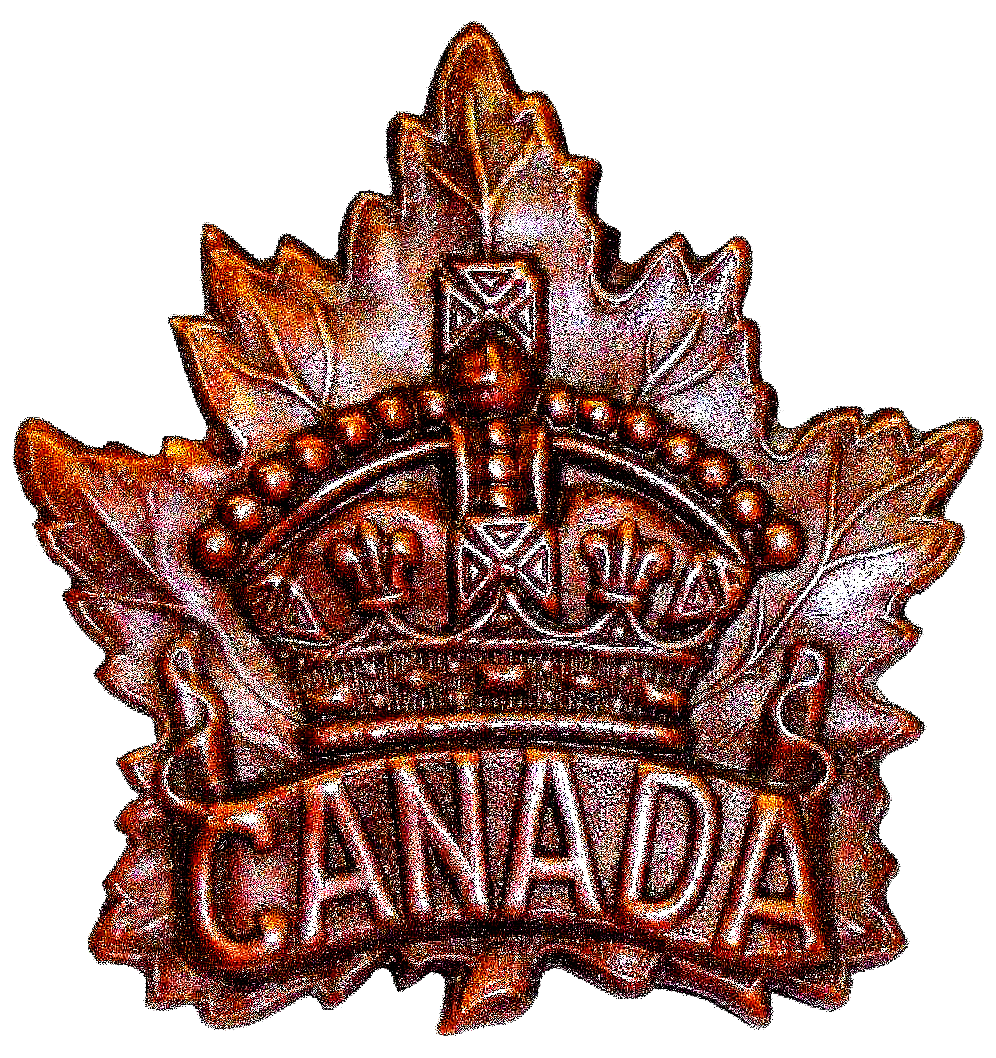
.png)
.png)
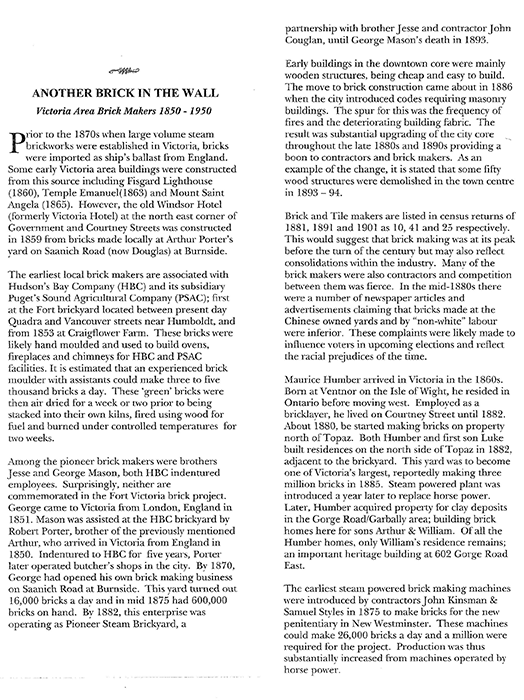
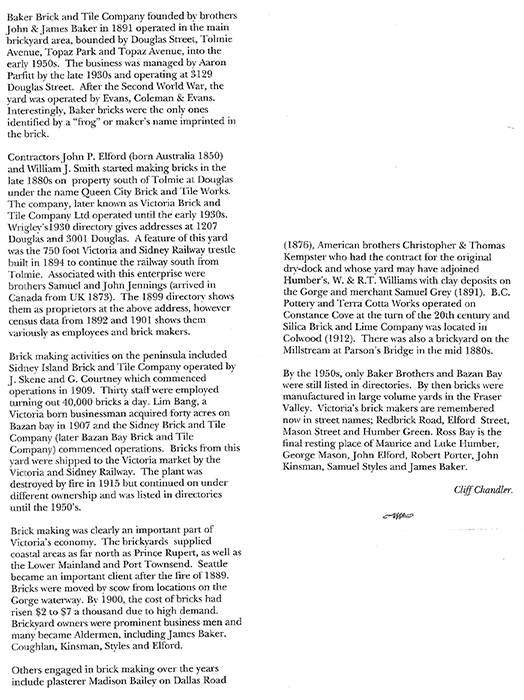
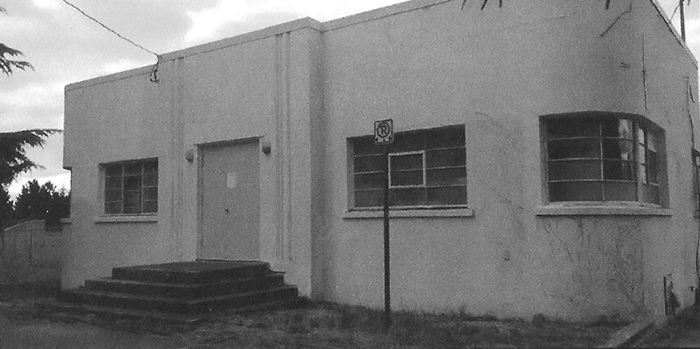
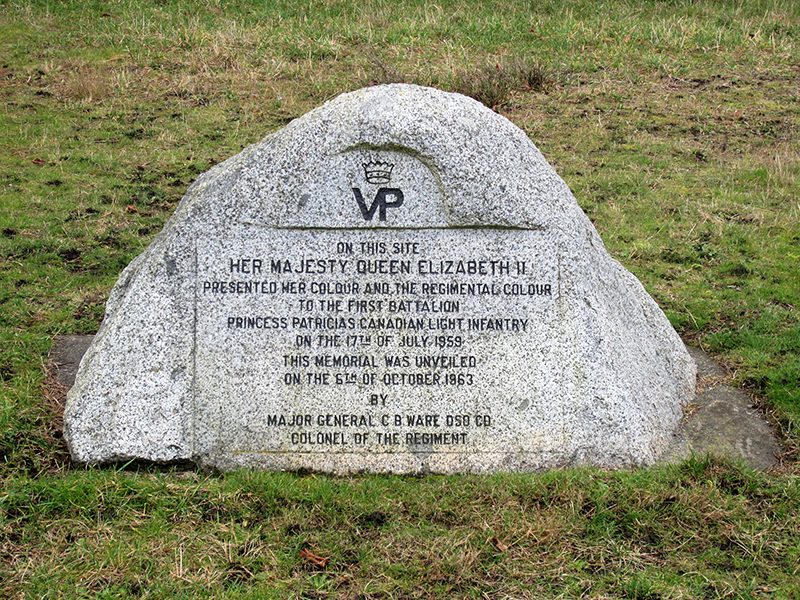
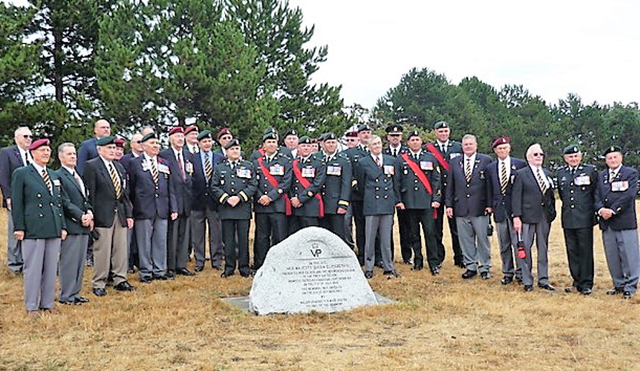
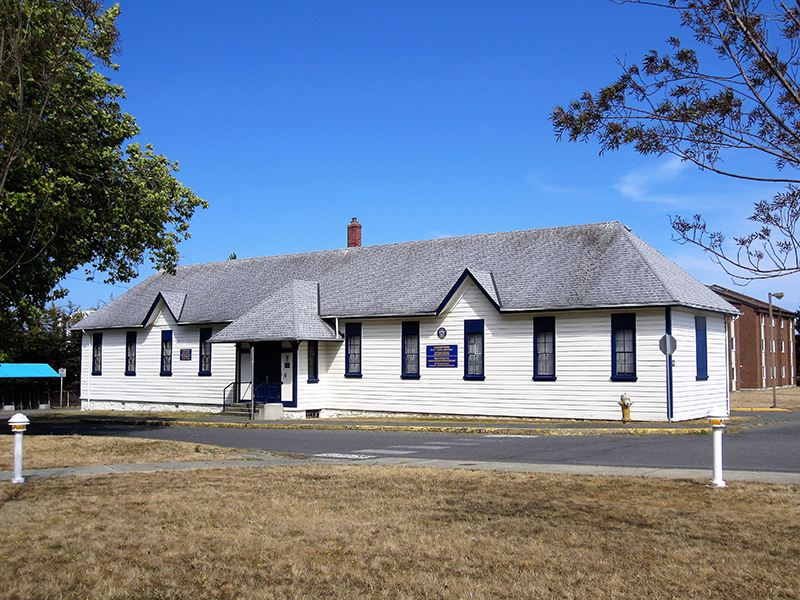
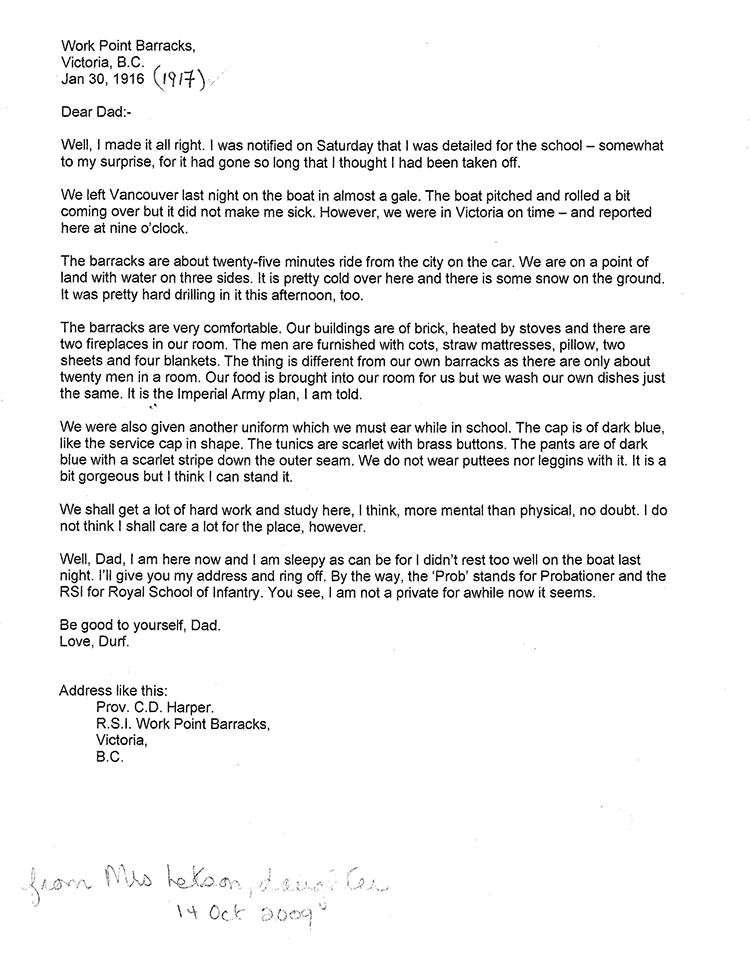
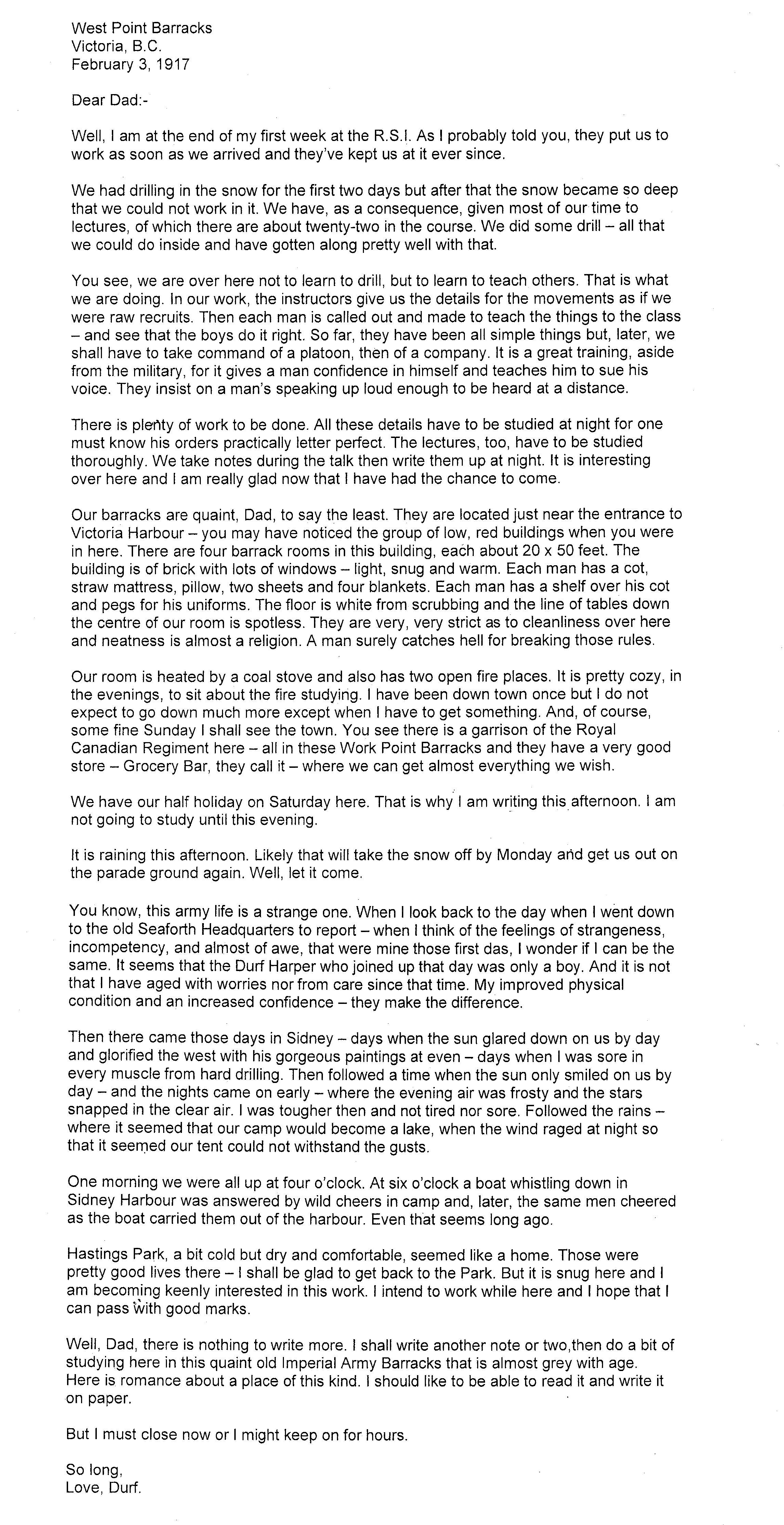
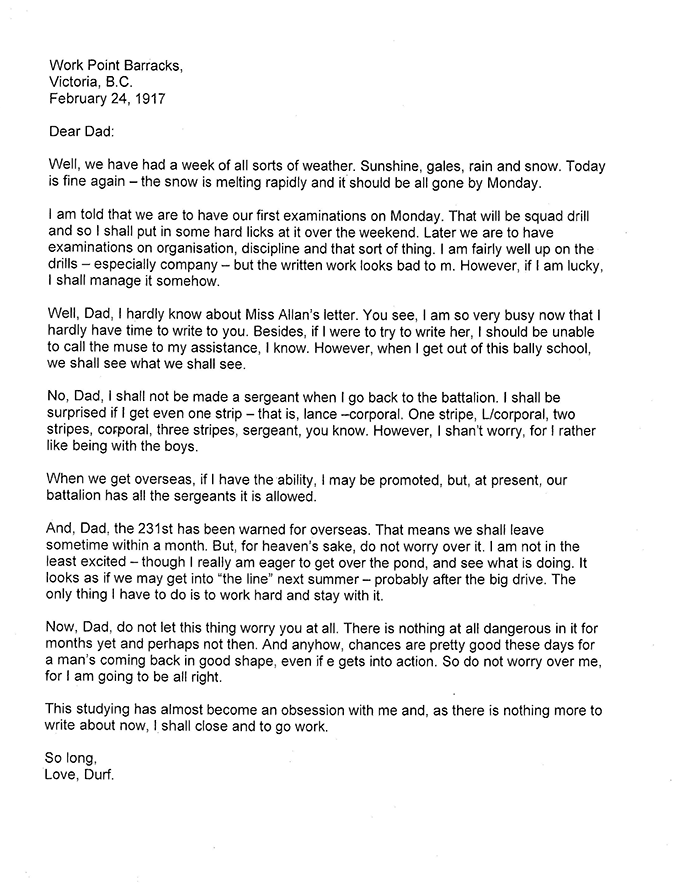
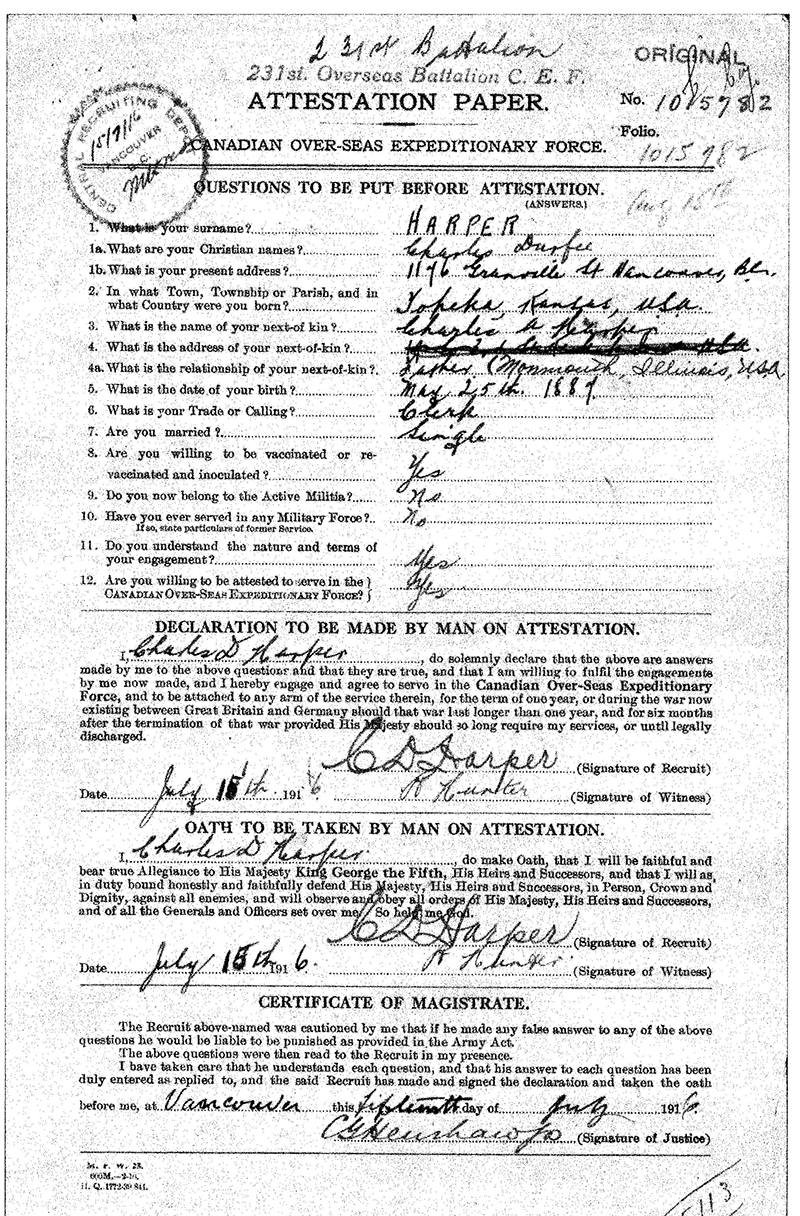
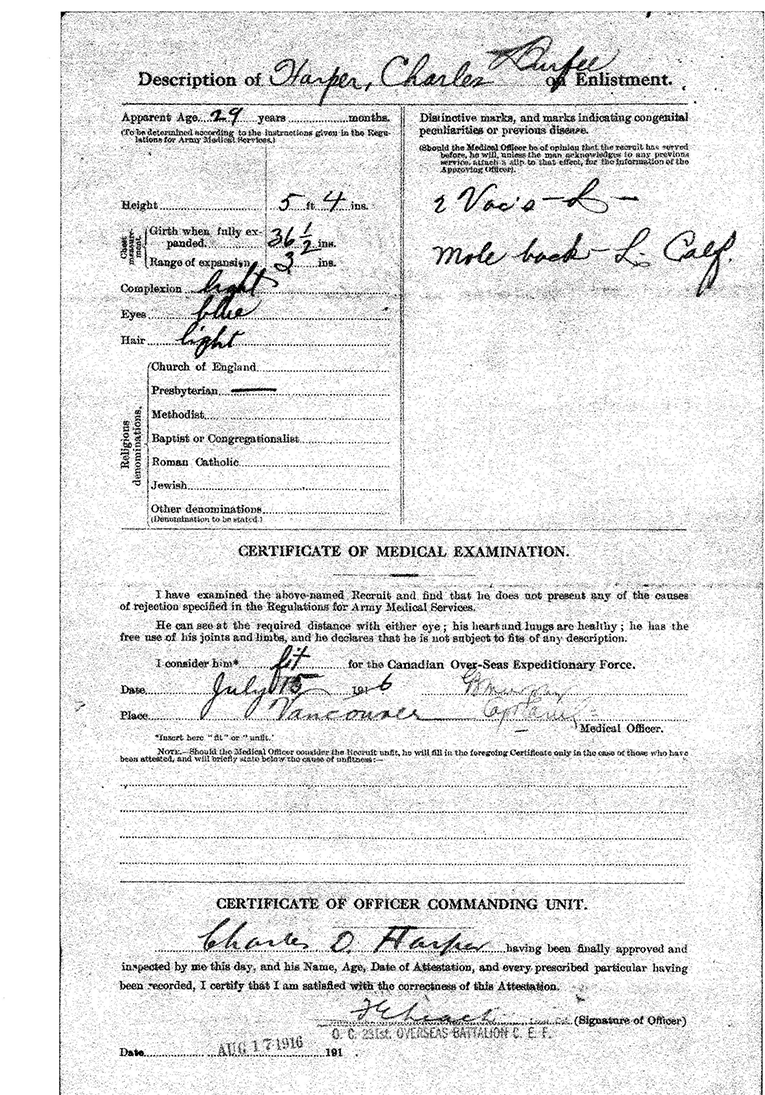
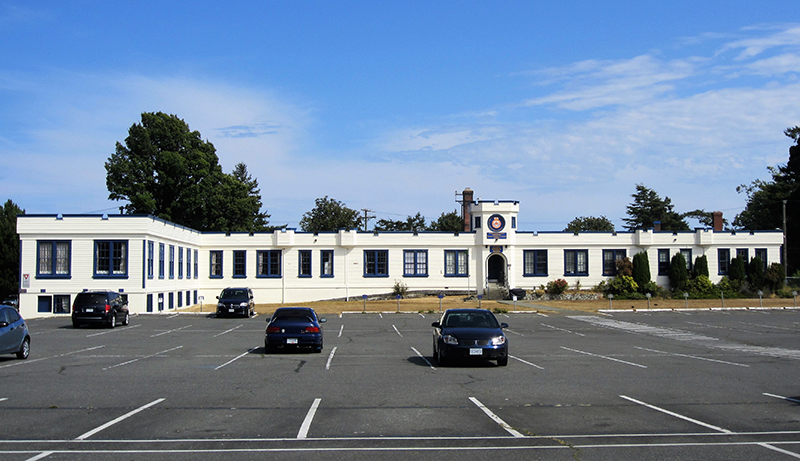
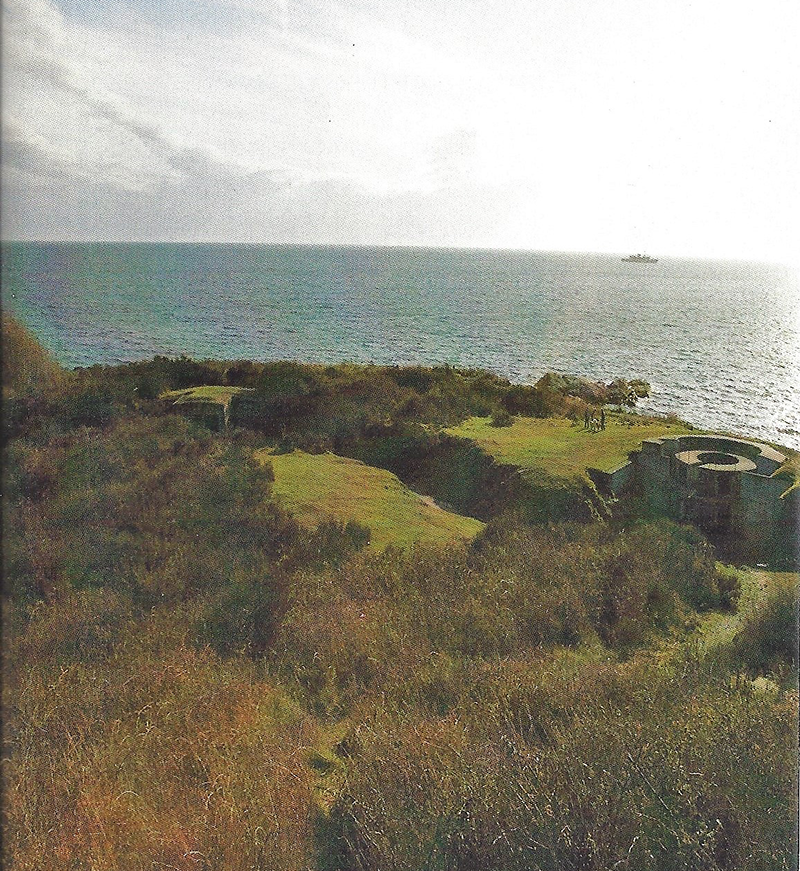
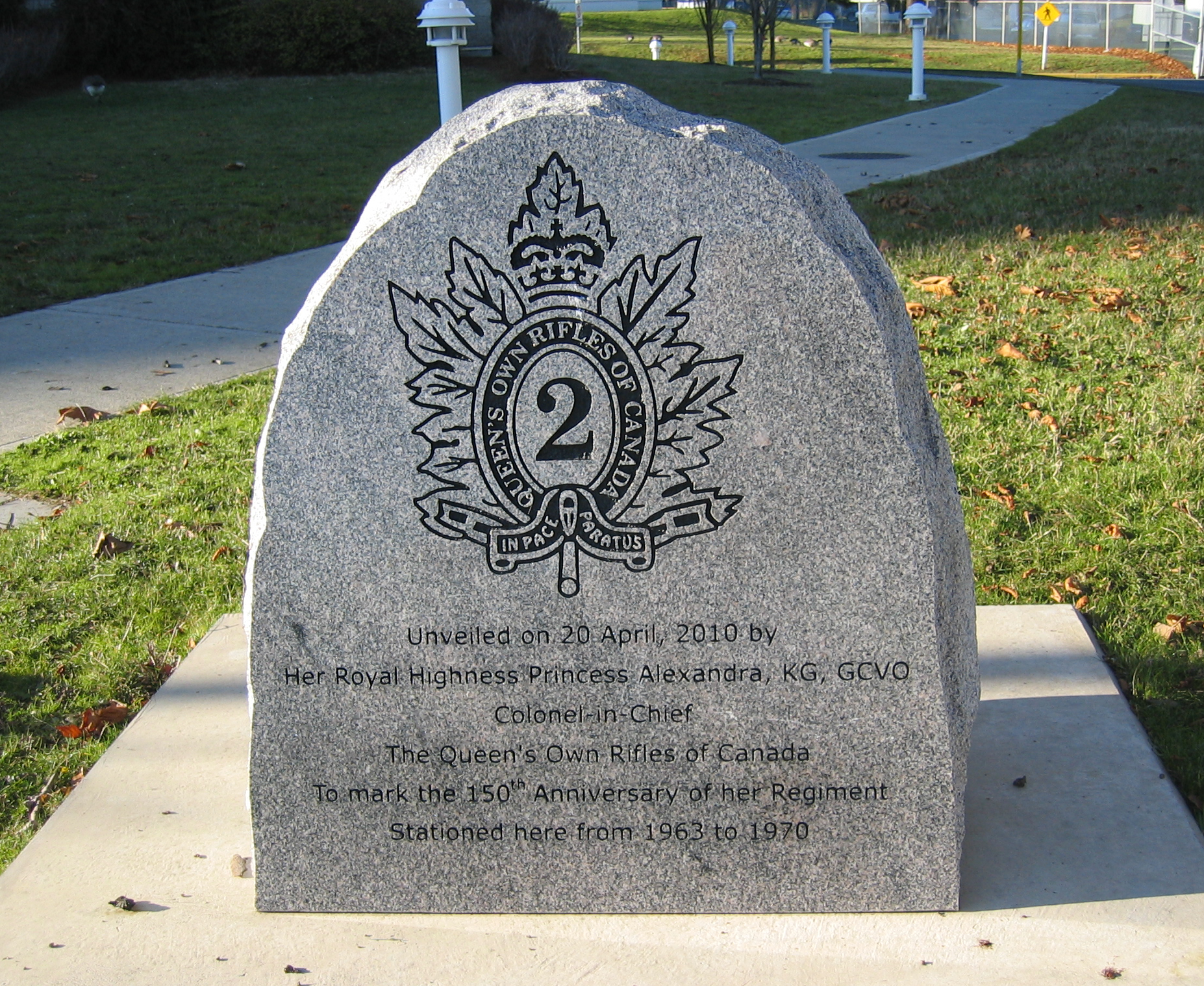
.png)
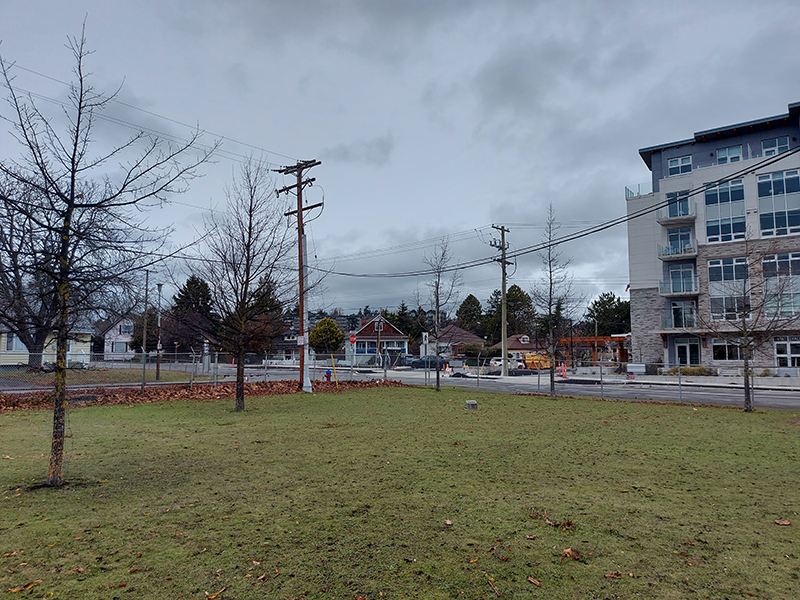
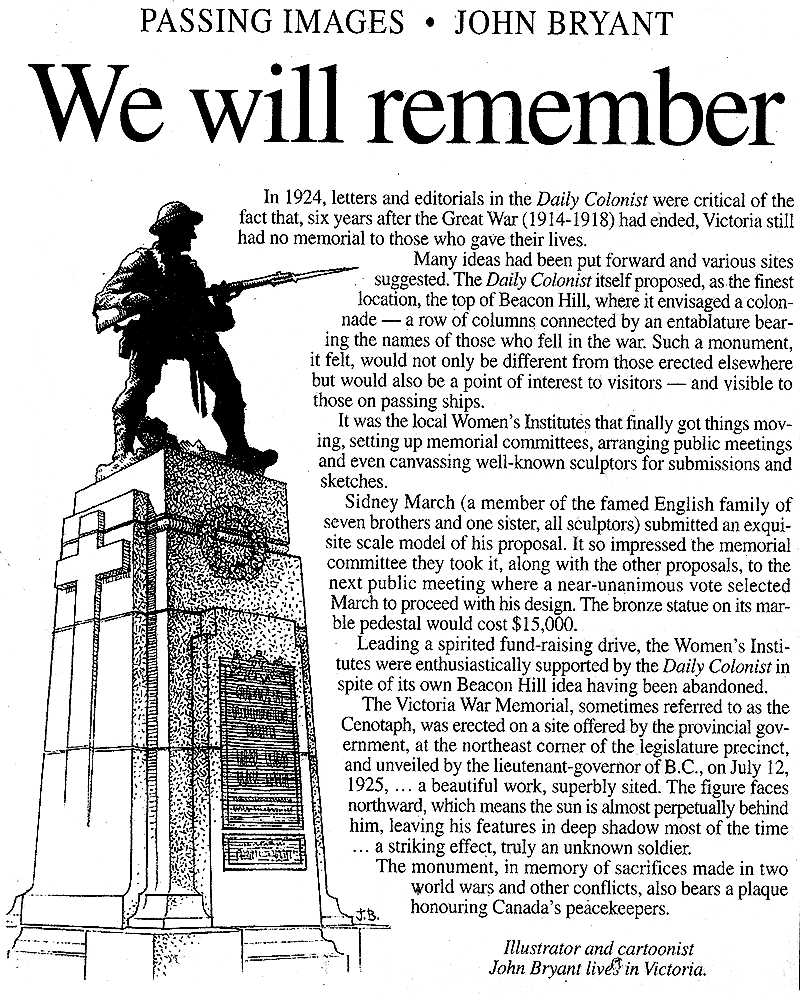
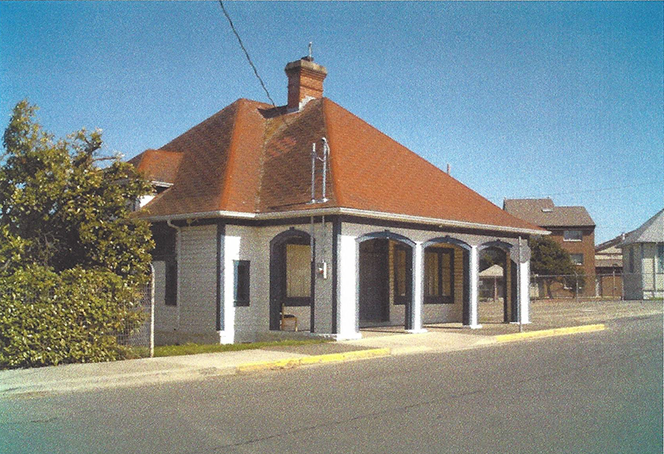
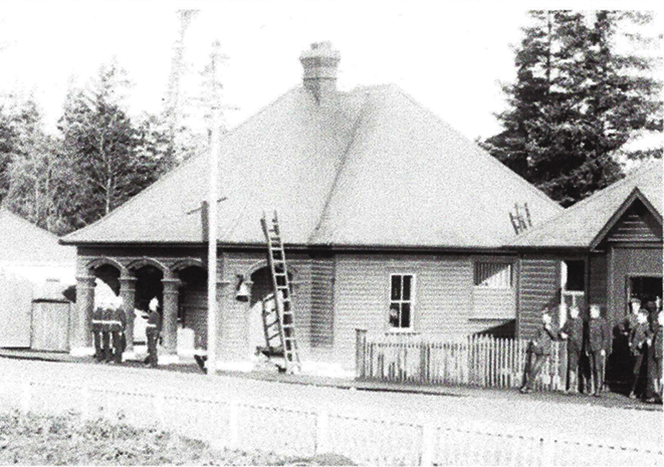
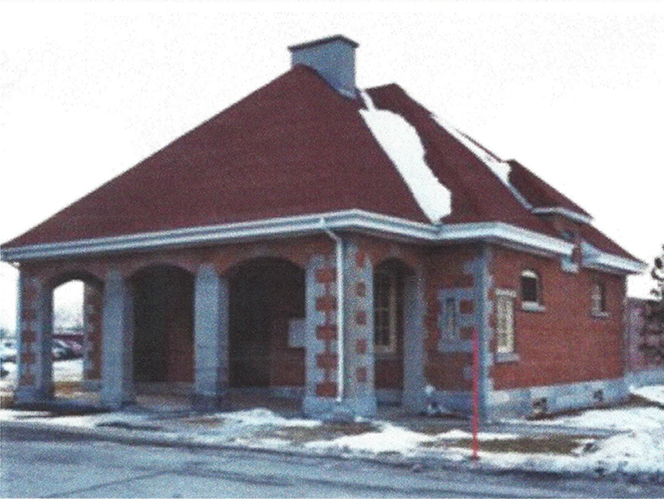
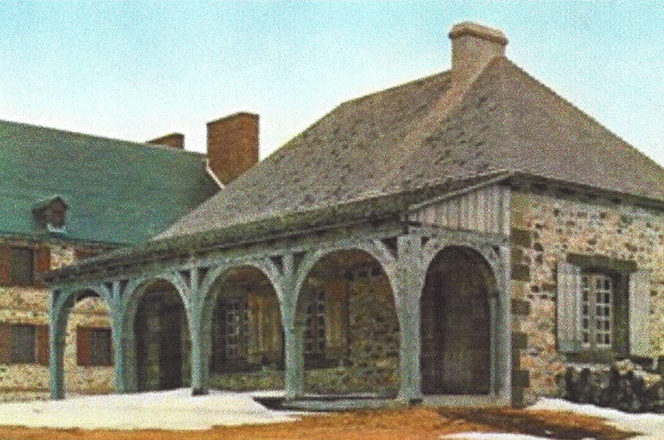
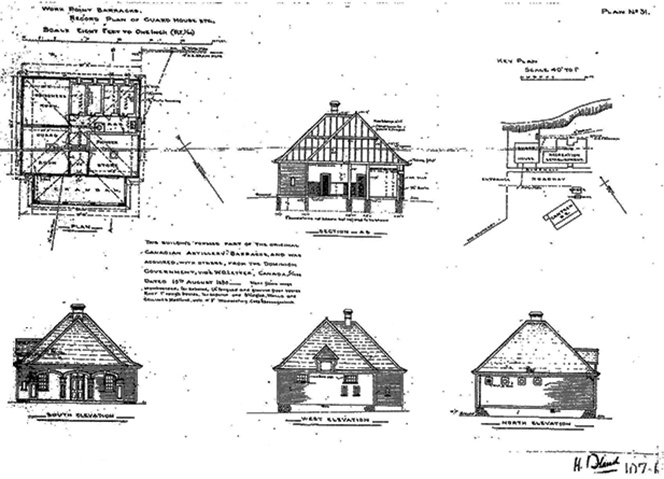
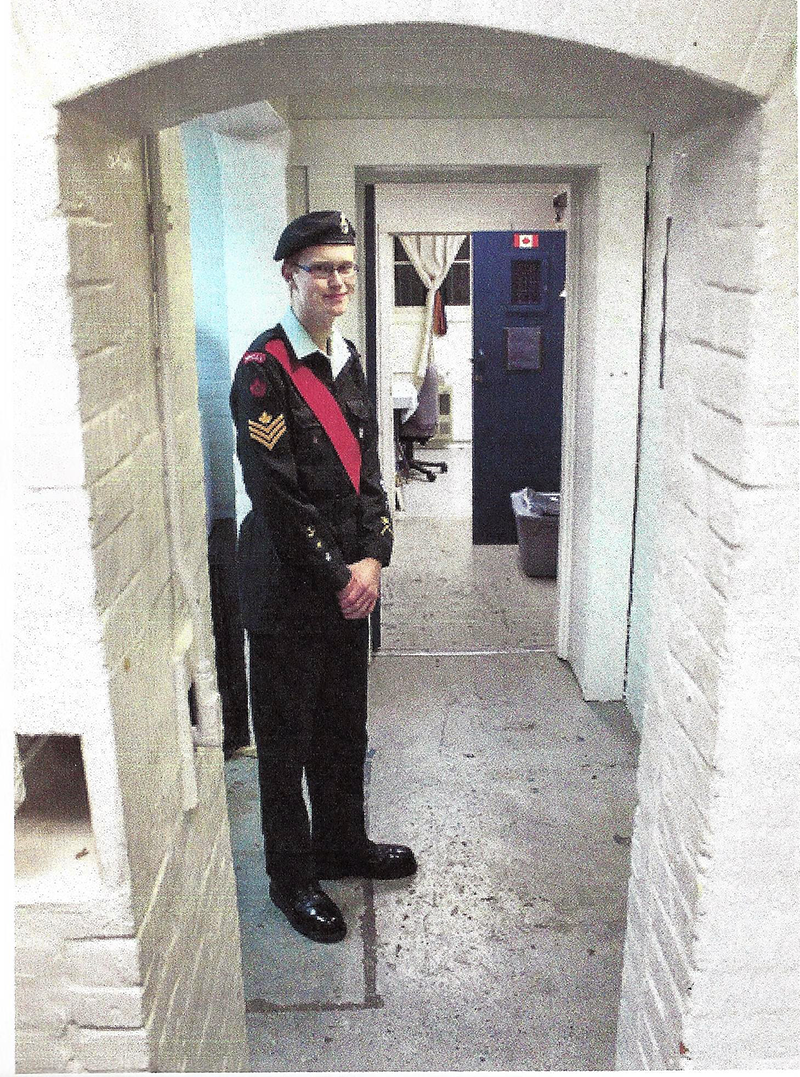
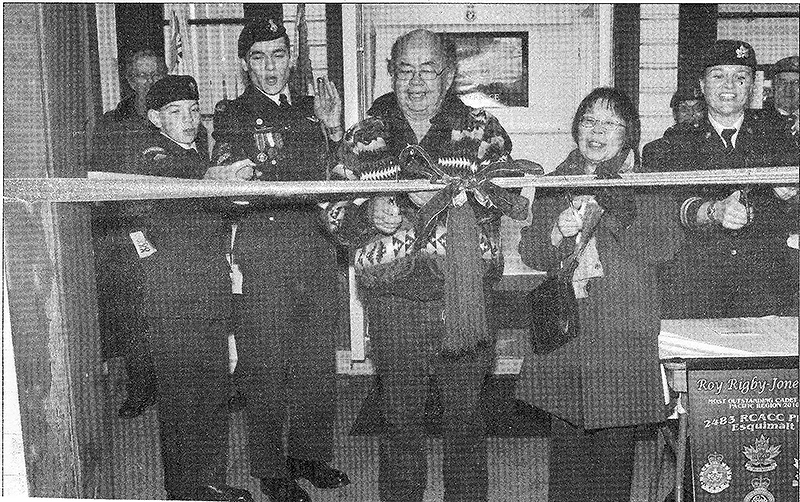
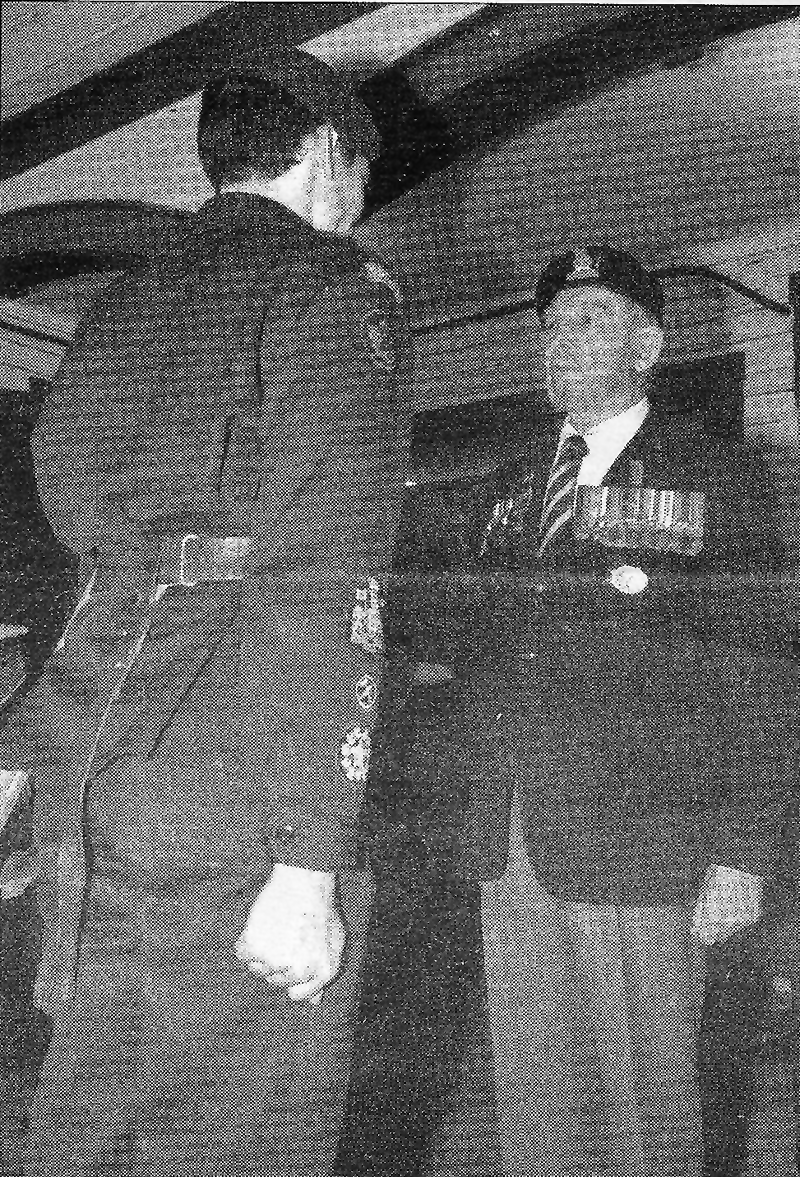
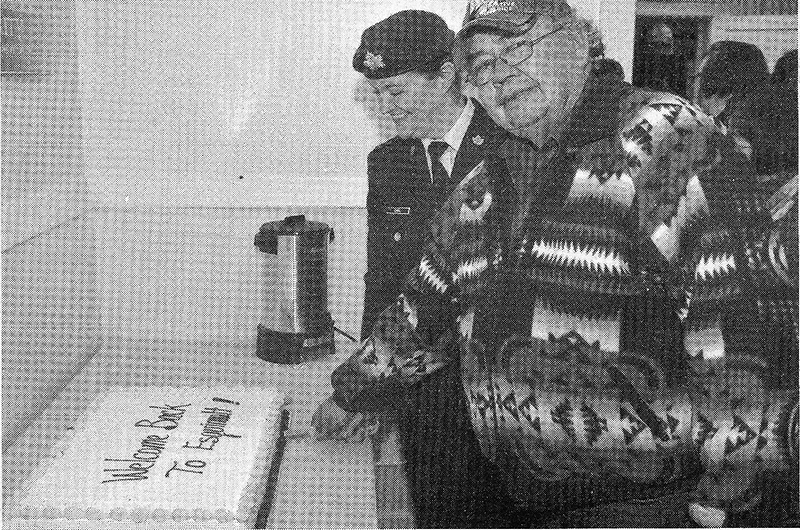
.png)
.png)
